Please Report Any Broken Links Or Trouble You Might Come Across To The Webmaster.
Please Take A Moment To Let Us Know So That We Can Correct Any Problems And Make Your Visit As Enjoyable And As Informative As Possible.
| Click On Image For Full Size |
Size | Image Description | Source | ||||||||||||||||||||||||||||||||||||||||||||||||||||||||||||||||||||||||||||||||||||||||||||||||||||||||||||||||||||||||||||||||||||||||||||||||||||||||||||||||||||||||||||||||||||||||||||||||||||||||||||||||||||||||||||||||||||||||||||||||||||||||||||||||||||||||||||||||||||||||||||||||||||||||||||||||||||||||||||||||||||||||||||||||||||||||||||||||||||||||||||||||||||||||||||||||||||||||||||||||||||||||||||||||||||||||||||||||||||||||||||||||||||||||||||||||||||||||||||||||||||||||||||||||||||||||||||||||||||||||||||||||||||||||||||||||||||||||||||||||||||||||||||||||||||||||||||||||||||||||||||||||||||||||||||||||||||||||||||||||||||||||||||||||||||||||||||||||||||||||||||||||||||||||||||||||||||||||||||||||||||||||||||||||||||||||||||||||||||||||||||||||||||||||||||||||||||||||||||||||||||||||||||||||||||||||||||||||||||||||||||||||||||||||||||||||||||||||||||||||||||||||||||||||||||||||||||||||||||||||||||||||||||||||||||||||||||||||||||||||||||||||||||||||||||||||||||||||||||
|---|---|---|---|---|---|---|---|---|---|---|---|---|---|---|---|---|---|---|---|---|---|---|---|---|---|---|---|---|---|---|---|---|---|---|---|---|---|---|---|---|---|---|---|---|---|---|---|---|---|---|---|---|---|---|---|---|---|---|---|---|---|---|---|---|---|---|---|---|---|---|---|---|---|---|---|---|---|---|---|---|---|---|---|---|---|---|---|---|---|---|---|---|---|---|---|---|---|---|---|---|---|---|---|---|---|---|---|---|---|---|---|---|---|---|---|---|---|---|---|---|---|---|---|---|---|---|---|---|---|---|---|---|---|---|---|---|---|---|---|---|---|---|---|---|---|---|---|---|---|---|---|---|---|---|---|---|---|---|---|---|---|---|---|---|---|---|---|---|---|---|---|---|---|---|---|---|---|---|---|---|---|---|---|---|---|---|---|---|---|---|---|---|---|---|---|---|---|---|---|---|---|---|---|---|---|---|---|---|---|---|---|---|---|---|---|---|---|---|---|---|---|---|---|---|---|---|---|---|---|---|---|---|---|---|---|---|---|---|---|---|---|---|---|---|---|---|---|---|---|---|---|---|---|---|---|---|---|---|---|---|---|---|---|---|---|---|---|---|---|---|---|---|---|---|---|---|---|---|---|---|---|---|---|---|---|---|---|---|---|---|---|---|---|---|---|---|---|---|---|---|---|---|---|---|---|---|---|---|---|---|---|---|---|---|---|---|---|---|---|---|---|---|---|---|---|---|---|---|---|---|---|---|---|---|---|---|---|---|---|---|---|---|---|---|---|---|---|---|---|---|---|---|---|---|---|---|---|---|---|---|---|---|---|---|---|---|---|---|---|---|---|---|---|---|---|---|---|---|---|---|---|---|---|---|---|---|---|---|---|---|---|---|---|---|---|---|---|---|---|---|---|---|---|---|---|---|---|---|---|---|---|---|---|---|---|---|---|---|---|---|---|---|---|---|---|---|---|---|---|---|---|---|---|---|---|---|---|---|---|---|---|---|---|---|---|---|---|---|---|---|---|---|---|---|---|---|---|---|---|---|---|---|---|---|---|---|---|---|---|---|---|---|---|---|---|---|---|---|---|---|---|---|---|---|---|---|---|---|---|---|---|---|---|---|---|---|---|---|---|---|---|---|---|---|---|---|---|---|---|---|---|---|---|---|---|---|---|---|---|---|---|---|---|---|---|---|---|---|---|---|---|---|---|---|---|---|---|---|---|---|---|---|---|---|---|---|---|---|---|---|---|---|---|---|---|---|---|---|---|---|---|---|---|---|---|---|---|---|---|---|---|---|---|---|---|---|---|---|---|---|---|---|---|---|---|---|---|---|---|---|---|---|---|---|---|---|---|---|---|---|---|---|---|---|---|---|---|---|---|---|---|---|---|---|---|---|---|---|---|---|---|---|---|---|---|---|---|---|---|---|---|---|---|---|---|---|---|---|---|---|---|---|---|---|---|---|---|---|---|---|---|---|---|---|---|---|---|---|---|---|---|---|---|---|---|---|---|---|---|---|---|---|---|---|---|---|---|---|---|---|---|---|---|---|---|---|---|---|---|---|---|---|---|---|---|---|---|---|---|---|---|---|---|---|---|---|---|---|---|---|---|---|---|---|---|---|---|---|---|---|---|---|---|---|---|---|---|---|---|---|---|---|---|---|---|---|---|---|---|---|---|---|---|---|---|---|---|---|---|---|---|---|---|---|---|---|---|---|---|---|---|---|---|---|---|---|---|---|---|---|---|---|---|---|---|---|---|---|---|---|---|---|---|---|---|---|---|---|---|---|---|---|---|---|---|---|---|---|---|---|---|---|---|---|---|---|---|---|---|---|---|---|---|---|---|---|---|---|---|---|---|---|---|---|---|---|---|---|---|---|---|---|---|---|---|---|---|---|---|---|---|---|---|---|---|---|---|---|---|---|---|---|---|---|---|---|---|---|---|---|---|---|---|---|---|---|---|---|---|---|---|---|---|---|---|---|---|---|---|---|---|---|---|---|---|---|---|---|---|---|---|---|---|---|---|---|---|---|---|---|---|---|---|---|---|---|---|---|---|---|---|---|---|---|---|---|---|---|---|---|---|---|---|---|---|---|---|---|---|---|---|---|---|---|---|---|---|---|---|---|---|---|---|---|---|---|---|---|---|---|---|---|---|---|---|---|---|---|---|---|---|---|---|---|---|---|---|---|---|---|---|---|---|---|---|---|---|---|---|---|---|---|---|---|---|---|---|---|---|---|---|---|---|---|---|---|---|---|---|
| Keel Laying / Commissioning 1917 - 1920 |
|||||||||||||||||||||||||||||||||||||||||||||||||||||||||||||||||||||||||||||||||||||||||||||||||||||||||||||||||||||||||||||||||||||||||||||||||||||||||||||||||||||||||||||||||||||||||||||||||||||||||||||||||||||||||||||||||||||||||||||||||||||||||||||||||||||||||||||||||||||||||||||||||||||||||||||||||||||||||||||||||||||||||||||||||||||||||||||||||||||||||||||||||||||||||||||||||||||||||||||||||||||||||||||||||||||||||||||||||||||||||||||||||||||||||||||||||||||||||||||||||||||||||||||||||||||||||||||||||||||||||||||||||||||||||||||||||||||||||||||||||||||||||||||||||||||||||||||||||||||||||||||||||||||||||||||||||||||||||||||||||||||||||||||||||||||||||||||||||||||||||||||||||||||||||||||||||||||||||||||||||||||||||||||||||||||||||||||||||||||||||||||||||||||||||||||||||||||||||||||||||||||||||||||||||||||||||||||||||||||||||||||||||||||||||||||||||||||||||||||||||||||||||||||||||||||||||||||||||||||||||||||||||||||||||||||||||||||||||||||||||||||||||||||||||||||||||||||||||||||||
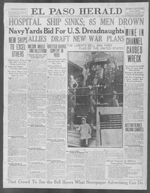 | 950k | Navy Yards Bid For U.S. Dreadnoughts. | Image and text provided by University of North Texas; Denton, TX. Photo from El Paso Herald.(El Paso, Tex.) 1901-1931, 17 November 1915, HOME EDITION, Image 1, via chroniclingamerica.loc.gov. 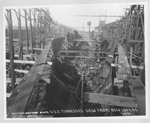 1.70k |
Tennessee (BB-43) view from bow looking stern-ward, 6 October 1917. |
Photo No. 3444, Brooklyn Navy Yard Archive - courtesy National Archive and Records Administration, Northeast Region - NYC, Record Group 181 via flickr.com. |  118k |
Tennessee (BB-43) under construction at New York Naval Shipyard, Brooklyn N.Y., 1 October 1918. In this view looking forward, the small plating can be seen rising in the stern area, the cylinders are the armored barbettes of the main battery; and forward of the second barbette, the slanting, side structures are the armored stack uptakes. |
USN photo and text courtesy of Warships in Profile, Volume 2, by John Wingate, Profile Publications LTD, Windsor, Berkshire, U.K. |
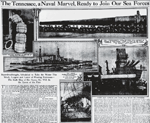 NR | The Tennessee (BB-43), a Naval Marvel, Ready to Join Our Sea Forces | Superdreadnought, Scheduled to Take the Water This Week, Largest and Latest of Floating Fortresses - The Sixth Ship of Her Name, She Will Be the Queen of the Fleet Image and text provided by The New York Public Library, Astor, Lenox and Tilden Foundation. | Photo from The Sun. (New York, [N.Y.]) 1916-1920, 27 April 1919, Section 7 Magazine Section, Image 75, via chroniclingamerica.loc.gov.  560k | Politicos and a bevy of fine clad women attend the launching of the Battleship Tennessee (BB-43) with FDR off to the side. | Photo by Buyenlarge/Getty Images courtesy of gettyimages.com.
| 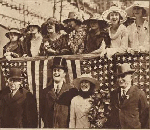 3.55k |
Text accompanying photo reads: "Miss Helen Roberts, sponsor for the Tennessee (BB-43), and daughter of Governor A. H., Roberts of Tennessee, her maids of honor & guests at the Tennessee's launching. |
Miss Roberts is Standing Between Assistant Secretary of the Navy Franklin D. Roosevelt and Her Father." "The U.S. super-dreadnought Tennessee (BB-43), MOST POWERFUL NAVAL BATTLE UNIT BUILT IN THE HISTORY OF THE WORLD. Gliding Down the Ways of the Brooklyn Navy Yard Into the East River at the First Public Launching at This Navy Yard Since Early in 1917, More Than 25,000 People Attending. The Tennessee, Will Displace 32, 600 Tons. It Is 624 Feet in Length, 97 Feet in Breadth, with a Mean Draft of 30 Feet 6 Inches. It Will Have an Indicated Horsepower of 28,000 and a Speed of Twenty-one Knots an Hour. Its Crew Will Consist of Fifty-eight Officers, 1,024 Men. It Will Be Exclusively Oil Burning and Electrically Driven, with an Armament of Twelve 14-Inch Guns and Fourteen 6- Inch Guns. The Tennessee, Though Named for a Bone-Dry State, Was Christened with Champagne, Over the Protest of Governor A. H., Roberts of Tennessee, Elected on a Prohibition Ticket." Photo by Times Wide World Photo, & text courtesy of N.Y. Times,, 4 May 1919, Page 2, courtesy of memory.loc.gov.
| 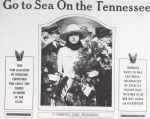 671k |
30 April 1919, Miss Helen Lenore Roberts, daughter of the governor of Tennessee christens the battleship Tennessee (BB-43). |
USN photo courtesy of Myron J. Smith Jr, from his book "Volunteer State Battlewagon", from Pictorial Histories Publishing, Missoula, Montana. | Image and text provided by Library of Congress, Washington, DC. Photo from Bisbee Daily Review. (Bisbee, Ariz.) 1901-1971, 11 May 1919, Image 10, via chroniclingamerica.loc.gov. 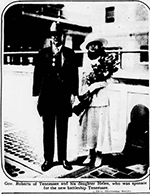 NR | Gov. Roberts of Tennessee and his daughter Helen, who was sponsor for the new battleship Tennessee (BB-43). | Image and text provided by Library of Congress, Washington, DC. | Photo & text by Evening Star. (Washington, D.C.) 1854-1972, 18 May 1919, Image 77, courtesy of chroniclingamerica.loc.gov. 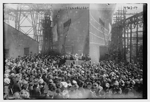 646k |
The champagne flies against the side of the Tennessee (BB-43) as Miss Helen Lenore Roberts christens the battleship. | Digital ID # ggbain 28726v, LC-B2-4903-14. Source: Library of Congress Prints and Photographs Division, from the George Grantham Bain Collection. | 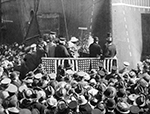 625k | Helen Roberts christening, 30 April 1919. | USN photo # Lot 10789-5, George C. Bain Collection. Courtesy of Library of Congress, from the National Museum of the U.S. Navy via flickr.com. | 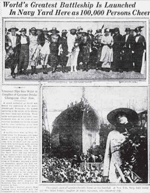 607k | World's Greatest Battleship Is Launched In Navy Yard Here as 100,000 Persons Cheer | Image and text provided by The New York Public Library, Astor, Lenox and Tilden Foundation. |
Photo from The Evening World. (New York, N.Y.) 1887-1931, 30 April 1919, Final Edition - Extra, Image 3, via chroniclingamerica.loc.gov. 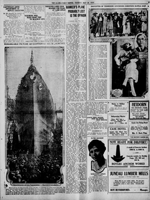 014319m NR |
REMARKABLE PICTURE AS GIANTESS OF SEA IS LAUNCHED |
Here is probably the most remarkable picture ever taken of a launching of a United States battleship. The camera shows the giant sea fighter just at the moment she was to start on her descent along the greased ways into the water. Miss Helen Roberts, daughter of the Governor of Tennessee, has just crashed a bottle of champagne against the sides of the monster vessel and is receiving the cheers of the thousands as another American dreadnought is added to the already long list of Uncle Sam's mighty fleet. It is easy to gather from the picture a striking image of the size of this vessel, which is the world's largest and most powerful dreadnought. Photo i.d. & text courtesy of Richard L. Jensen. | Image and text provided by Alaska State Library Historical Collections. Photo from The Alaska Daily Empire. [volume] (Juneau, Alaska) 1912-1926, 20 May 1919, Image 5, via chroniclingamerica.loc.gov.  405k | The launching of the Tennessee (BB-43) at the New York Navy Yard on April 30. | Image and text provided by The New York Public Library, Astor, Lenox and Tilden Foundation. | Photo by The Sun. (New York [N.Y.]) 1916-1920, 11 May 1919, Section 5 Pictorial Section, Image 50, courtesy of chroniclingamerica.loc.gov. 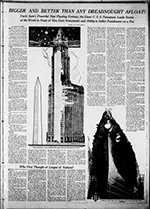 2.31k | Uncle Sam's Powerful New Floating Fortress the Giant Tennessee (BB-43), Leads Navies of the World in Point of Size, Armament and Ability to Inflict Punishment on a Foe. | Standing on her bow the Tennessee would tower nearly a hundred feet higher than the Washington Monument, or about three-fourths the way to the top of the Woolworth Building. Image and text provided by State Historical Society of North Dakota. | Photo by Grand Forks Herald. (Grand Forks, N.D.) 1916-1955, 15 July 1919, Image 1, courtesy of chroniclingamerica.loc.gov. 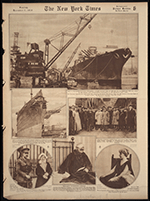 679k |
"The U.S. super-dreadnought Tennessee (BB-43), largest battle unit of the sea so far designed for any navy in the world now approaching completion in the Brooklyn Navy Yard." |
Photo by Underwood & Underwood, courtesy of memory.loc.gov. | Text courtesy of N.Y. Times 7 December 1919, Page 7. 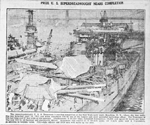 NR |
PRIZE U.S. Superdreadnought NEARS COMPLETION | Image and text provided by University of Utah, Marriott Library. | Photo from The Ogden Standard. (Ogden City, Utah) 1913-1920, 03 January 1920, LAST EDITION - 4 P.M., Image 4, via chroniclingamerica.loc.gov. 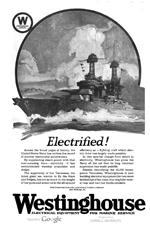 521k | Electrifing Tennessee (BB-43). | Photo courtesy of A&N Journal via Ron Reeves (of blessed memory).
| 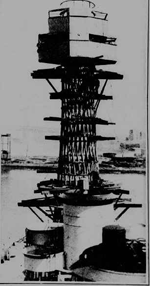 21k | The fighting top with which the new Tennessee (BB-43) is equipped. Uncle Sam's new super-dreadnought, one of the largest and most powerful afloat, is soon to be placed in commission at the Brooklyn navy yard. | Image and text provided by Library of Congress, Washington, DC. | Photo by New-York Tribune.(New York [N.Y.]) 1866-1924, 11 April 1920, Image 53 courtesy of chroniclingamerica.loc.gov. 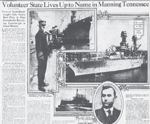 NR |
Volunteer State Lives Up to Name in Manning Tennessee (BB-43) | Newest Superdreadnought Gets Native Born Crew in Most Remarkable Recruiting Campaign in Naval History. Image and text provided by The New York Public Library, Astor, Lenox and Tilden Foundation. | Photo from The Sun and the New York Herald. (New York [N.Y.]) 1920-1920, 11 April 1920, Section 7 Magazine Section, Image 75, via chroniclingamerica.loc.gov. 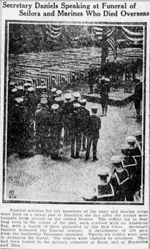 014320b NR |
Secretary Daniels Speaking at Funeral of Sailors and Marines Who Died Overseas. |
Funeral services for 151 members of the navy and marine corps were held on a naval pier in Brooklyn the day after they were brought from abroad on the collier Nereus (AC-10). The coffins lay in four long rows in the center of the pier, each covered with an American flag, with a bunch of lilies presented by the Red Cross. Secretary Daniels delivered the funeral oration. A detachment of 200 men from the battleship Tennessee (BB-43) attended. Twenty-six bodies were sent to Arlington for burial. The others were claimed by relatives. They had been buried in the military cemetery at Brest, Marseilles & Nice. Image and text provided by University of New Mexico. | Photo from Albuquerque Morning Journal. [volume] (Albuquerque, N.M.) 1903-1926, 02 June 1920, CITY EDITION, Editorial, Image 7, via chroniclingamerica.loc.gov. 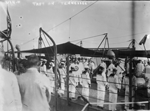 014315 1.02k |
President William Howard Taft aboard the Tennessee (BB-43) during her commissioning on 3 June 1920. |
Prints and Photographs Division, from the George Grantham Bain Collection, Reproduction Number; LC-DIG-ggbain-08891 |
Photo courtesy of Bain News Service, publisher courtesy of loc.gov 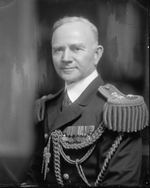 141k |
Admiral Richard Henry Leigh, then a Captain, was the Commanding Officer for the battleship Tennessee (BB-43) when she was commissioned on 3 June 1920 and continued as her commander until 1921.
|
Photo courtesy of the Library of Congress via Bill Gonyo. |  743k |
The Battleship Tennessee (BB-43) is Equipped with "Wear-Ever" Aluminum Steam Jacketed Kettles | The Battleship Tennessee newest and finest ship in the U. S. Navy reflects the most modern ideas in construction and equipment...... Image and text provided by Penn State University Libraries; University Park, PA. |
Photo from Evening Public Ledger. (Philadelphia [Pa.] 1914-1942, 3 June 1920, NIGHT EXTRA FINANCIAL, Image 10, courtesy of chroniclingamerica.loc.gov.  NR | Left to right | Capt. Richard Henry Leigh (left) and Commander A. F. Stanton, commander and executive officer respectively of the Tennessee (BB-43), just placed in commission. Citizens of Tennessee inspecting the forward turret and giant guns of the great battleship named for their State and just placed in commission at the Navy Yard in Brooklyn where she was built. Image and text provided by The New York Public Library, Astor, Lenox and Tilden Foundation. | Photo & text by The Sun and the New York Herald. (New York [N.Y.]) 1920-1920, 13 June 1920, Section 5 Rotographic Section, Image 60, courtesy of chroniclingamerica.loc.gov.  80k |
Recruiting poster for the Tennessee (BB-43). |
USN photo courtesy of Myron J. Smith Jr, from his book "Volunteer State Battlewagon", from Pictorial Histories Publishing, Missoula, Montana. |
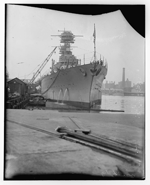 539k |
Tennessee (BB-43) dockside sometime shortly after her commissioning. |
Digital ID # ggbain 30527v, LC-B2-5198-13. Source: Library of Congress Prints and Photographs Division, from the George Grantham Bain Collection. | 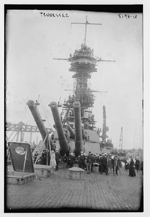 93k |
Men and women gather on the deck of the Tennessee (BB-43) sometime shortly after her commissioning. |
Digital ID # ggbain 30524v, LC-B2-5198-13. Source: Library of Congress Prints and Photographs Division, from the George Grantham Bain Collection. |  103k |
Tennessee (BB-43) completing after launching at Brooklyn. Outline of armor belt can be seen below the lower line of ports. The Battleship in the background is probably the Nevada (BB-36). |
USN photo and text courtesy of Warships in Profile, Volume 2, by John Wingate, Profile Publications LTD, Windsor, Berkshire, U.K. |
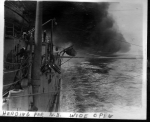 791k |
A cloud of smoke trails behind the Tennessee (BB-43) while at full power, 21.9 knots as she heads for N.Y. after conducting trials in Long Island Sound from 15 to 23 October 1920. |
Photo from the James R. Nehez, Sr. collection, courtesy of James R. Nehez, III. Partial text courtesy of DANFS. |
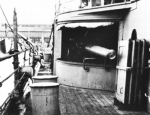 41k |
One of Tennessee's (BB-43) 5in/51 guns in its case-mate 30 August 1920, starboard side looking aft. Shutters for the gun are secured to the bulkhead just forward of the gun. |
USN photo and text courtesy of Warships in Profile, Volume 2, by John Wingate, Profile Publications LTD, Windsor, Berkshire, U.K. |
 33k |
Tennessee's (BB-43) flag locker aft, 12 October 1920. There was storage furnished for 150 signal flags. The canvas covered objects around the mainmast are searchlights. |
USN photo and text courtesy of Warships in Profile, Volume 2, by John Wingate, Profile Publications LTD, Windsor, Berkshire, U.K. |
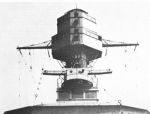 26k |
Control tower, bridge, forward main battery director and foremast on Tennessee (BB-43), 12 October 1920. The three level observation and fire control tops on the foremast were first used by the USN on Tennessee. |
USN photo and text courtesy of Warships in Profile, Volume 2, by John Wingate, Profile Publications LTD, Windsor, Berkshire, U.K. |
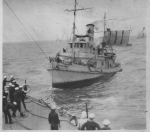 915k |
After fitting out, Tennessee (BB-43) conducted trials in Long Island Sound from 15 to 23 October 1920. While Tennessee was at New York, one of her 300-kilowatt ship's-service generators blew up on 30 October "completely destroying the turbine end of the machine" and injuring two men. Undaunted, the ship's force, navy yard craftsmen, and manufacturers' representatives labored to eliminate the "teething troubles" in Tennessee's engineering system and enabled the battleship to depart New York on 26 February 1921 for standardization trials at Guantanamo. She next steamed north for the Virginia Capes and arrived at Hampton Roads on 19 March. Tennessee carried out gunnery calibration firing at Dahlgren, Va., and was drydocked at Boston before full-power trials off Rockland, Maine. After touching at New York, she steamed south; transited the Panama Canal; and, on 17 June, arrived at San Pedro, Calif., her home port for the next 19 years. |
A tug boat taking a target barge out for the Tennessee (pictured behind the barge) while conducting gunnery calibration firing at Dahlgren, Va. Photo from the James R. Nehez, Sr. collection, courtesy of James R. Nehez, III. |
Partial text courtesy of DANFS. 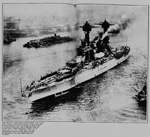 365k |
THE WORLD'S BIGGEST BATTLESHIP, your Uncle Sam's super-dreadnought Tennessee (BB-43), as seen from the Brooklyn Bridge a week ago Friday as she put out to sea on her trial trip. She is 630 feet long, of 32,500 tons, .53,000 horsepower, burns oil, of which she can carry 1,900 tons, cost over $22,000,000, and is the first ship to recruit her personnel in the state after which she is named.
| Image and text provided by Library of Congress, Washington, DC. & censored by Tom Kermen. |
Photo from New-York Tribune. (New York [N.Y.]) 1866-1924, 24 October 1920, Image 54 & 55, courtesy of chroniclingamerica.loc.gov. Roaring 20's thru 30's |
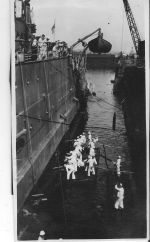 729k |
Work detail preparing for drydocking. |
Photo from the James R. Nehez, Sr. collection, courtesy of James R. Nehez, III. |
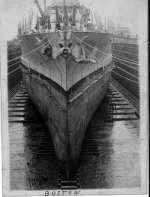 869k |
Tennessee (BB-43) is pictured in Boston Dry Dock, March, 1921. |
Photo from the James R. Nehez, Sr. collection, courtesy of James R. Nehez, III. |
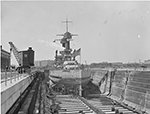 449k |
Tennessee (BB-43) in drydock. | Photo # 08_06_004657 from the Boston Public Library, Leslie Jones collection, courtesy of Kate Monea, Archivist, USS Constitution Museum. |
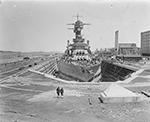 449k |
Tennessee (BB-43) docks in New dry dock in South Boston. | Photo # 08_06_005164 from the Boston Public Library, Leslie Jones collection, courtesy of Kate Monea, Archivist, USS Constitution Museum. |
 NR |
FULL SPEED AHEAD | First trial trip of the U.S. Battleship Tennessee (BB-43) off the coast of Maine. This is Uncle Sam's largest and latest pet. Image and text provided by Oklahoma Historical Society. | Photo & text by The Daily Ardmoreite.(Ardmore, Okla.) 1893-current, 12 June 1921, HOME EDITION, Image 11, courtesy of chroniclingamerica.loc.gov. 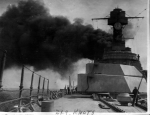 738k |
Chugging along at full power, 21.9 knots during trials. |
Photo from the James R. Nehez, Sr. collection, courtesy of James R. Nehez, III. |
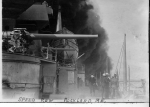 744k |
Full Power Trials at Rockland, ME., circa May 1921. |
Photo from the James R. Nehez, Sr. collection, courtesy of James R. Nehez, III. |
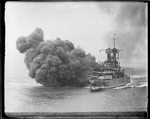 329k |
A Tennessee (BB-43) class battleship firing a broadside. |
Photo courtesy of the Boston Public Library, Leslie Jones Collection via flickr.com. | 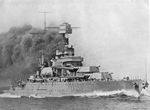 1.20k |
Black & white in color photo of Tennessee (BB-43) underway at high speed with its background possibly enshrouded from her fumes from her aft main battery during target practice; her main forward battery is trained out to starboard, taken during her full power trials. | USNI Photo Navy Recruiting Bureau, N.Y. Photo courtesy of Pieter Bakels & Tim Muir.
|  552k |
Swabbies swabbing. |
Photo from the James R. Nehez, Sr. collection, courtesy of James R. Nehez, III. |
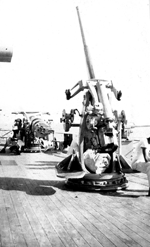 014306 376k |
1920's shot of a 3" gun mount of Tennessee (BB-43). |
Photo from The Collection of S. Honour. |
 237k | Foreground is definitely Tennessee (BB-43). In the middle is Idaho (BB-42) (darker camouflage note also the fantail catapult) and upper right is Arizona (BB-39), less certain but based on main mast platforms verses the New Mexico (BB-40). Middle background is New York (BB-34) (navigation bridge not over hanging conning tower). The far left background is the Texas (BB-35) (blunt bow, 2 funnels). |
The aircraft is a Naval Aircraft Factory / Curtiss / Canadian Aeroplane Ltd F-5L. The date of Mr. Kreisman's photo has to be 1920-1921. By 1922 all 14" and 16" gunned BB's (except New York and Texas as the 5th turret did not leave enough deck space) had been fitted with a compressed air catapult on the stern. The presence of a stern A/C catapult on only one of the three 1916 program BB's suggest this early in the introduction of this equipment but late enough for the turret top fly-off platforms to have been removed from all ships present. In 1919 the Battle Fleet shifted its base to San Pedro in California where it remained based until shifted to Pearl Harbor. The Texas and New York were assigned to that fleet until they returned east for modernization in 1925. This would suggest that the photo was taken some where in the Pacific. The rich flora onshore suggest a tropical climate and the enclosed by would lead me to guess Panama or Gitmo. If the 1920 or 1921 Fleet problem was conducted in Atlantic waters could explain an Atlantic based aircraft with a Pacific based Fleet. Photo courtesy of Lance Kreisman via Fabio Pen~a. | Photo & text i.d. courtesy of Chris Hoehn, Alan Moore & Richard Jensen. Aircraft i.d. courtesy of Alan Moore via Larkins, William T. US Navy Aircraft 1921-1941/US Marine Corps Aircraft 1914-1959. [The image came from the USMC aircraft section, pg(9).] Atglen, PA: Schiffer Publishing, 1995. (originally published as US Marine Corps Aircraft 1914-1959, copyright 1959, and US Navy Aircraft 1921-1941, copyright 1961). 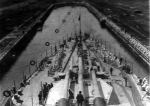 589k |
In the Panama Canal, June 1921. |
Photo from the James R. Nehez, Sr. collection, courtesy of James R. Nehez, III. |
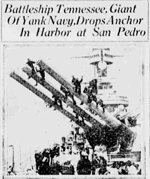 540k |
Battleship Tennessee (BB-43), Giant Of Yank Navy, Drops Anchor In Harbor at San Pedro | Image and text provided by Oklahoma Historical Society. |
Photo & text by The Morning Tulsa Daily World. (Tulsa, Okla.) 1919-1927, 03 July 1921, FINAL EDITION, SECTION B, Image 24, courtesy of chroniclingamerica.loc.gov.  014300k 342k |
1921 Print Military Battleship Tennessee (BB-43) 50 Caliber Guns |
Photo courtesy of periodpaper.com |
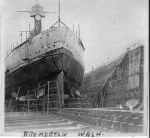 923k |
In the dry dock at Bremerton WA, post June 1921. |
Photo from the James R. Nehez, Sr. collection, courtesy of James R. Nehez, III. |
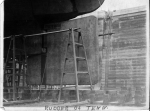 923k |
Rudder of the Tennessee (BB-43) at the dry dock, Bremerton WA, post June 1921. |
Photo from the James R. Nehez, Sr. collection, courtesy of James R. Nehez, III. |
 384k | Tennessee (BB-43) entering Vancouver Harbour, circa 5 August 1921. | Photo # AM256-S3-2-: CVA 770-90 via Gowen-Sutton Company Limited via searcharchives.vancouver.ca courtesy of John Hummel, USN (Retired).
| 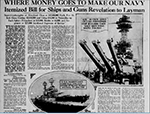 815k | WHERE MONEY GOES TO MAKE OUR NAVY | Itemized Bill for Ships and Guns Revelation to Layman Superdreadnoughts of Maryland Class at $42,000,000 Each, Fire 16-Inch Guns Costing $2,048,000 and Using $18,000 in Projectiles for Each Salvo. Torpedoes at $15,000, Bombs at $4,000, and Airplanes at $27,000 Incidental Expenses of Service SIX 14--INCH GUNS ON TENNESSEE (BB-43) COST $116,000 EACH, EACH SHOT $900. SALVO $ 10,800: MARYLAND (BB-46) COST $4-2,000,000 UPKEEP $750,000 YEARLY PAYROLL. $1,200,000. United States Navy 14-inch gun on a railroad carriage for testing. Extreme range 30 miles, projectile weighs 1,400 pounds, carriage, 320 tons. Battleships of the Tennessee class carry twelve of these monster weapons. Image and text provided by Library of Congress, Washington, DC. | Photo & text by The New York Herald. (New York, N.Y.) 1920-1924, 11 September 1921, SECTION SEVEN, Image 75, courtesy of chroniclingamerica.loc.gov.  1.26k | Two views of Tennessee (BB-43) anchored off Vancouver Harbour. | Photo # AM256-S3-2-: CVA 770-90 by Walter E. Frost via Gowen-Sutton Company Limited searcharchives.vancouver.ca courtesy of Mike Green.
| 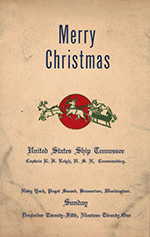 8.03k | 8 page PDF of the Tennessee (BB-43) Christmas program and menu, 1921.
|
Photos courtesy of David A. Jones, MCPO USN (Ret.)
|  81k |
Tennessee (BB-43) photographed in 1922 with YC-159 alongside. Across the Pier is the Canadian Pacific Liner Empress of Austraila. |
The markings on turrets II & III were bearing marks by which the ships ahead and behind in the battle line could determine on which relative bearing the main battery was training. The black strip at the waterline is the 14in-thick armor belt. Photo i.d. courtesy of Tom Jacobs. |
USN photo NH 44254, courtesy of Myron J. Smith Jr, from his book "Volunteer State Battleground", from Pictorial Histories Publishing, Missoula, Montana. Text courtesy of Warships in Profile, Volume 2, by John Wingate, Profile Publications LTD, Windsor, Berkshire, U.K. 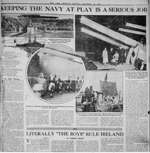 1.40k | Keeping the Navy at play is a serious job aboard the Tennessee (BB-43) at Gitmo, 19 November 1922. |
Image provided by: Library of Congress, Washington, DC. |
PDF courtesy of New-York Tribune. (New York [N.Y.]) 1866-1924, 19 November 1922, Page 3, Image 63, via chroniclingamerica.loc.gov. 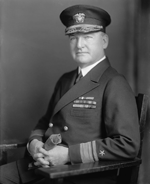 106k | Captain Luke R. McNamee was the commanding officer of the battleship Tennessee (BB-43) from 1923 to 1924. Under Captain McNamee the Tennessee made the fleet's highest score in gunnery for the years 1923 to 1924; she won the Efficiency Pennant for the highest combined score in gunnery and engineering in the latter year.
| Photo from the Library of Congress & via Bill Gonyo. |
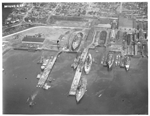 013416 609k | Two photographs of Puget Sound, Navy Yard, Bremerton, Washington, 21 August 1923. |
The nearest BB , bow on, is the Texas (BB-35), identified by her distinctive pilot house. New York (BB-34) is next, with all the awnings, and the Tennessee class ship in the drydock is most likely California (BB-44). At the time of the photos, Tennessee (BB-43) had a unique searchlight structure around the second stack which is not apparent here, but neither of the shots is clear enough to be absolutely certain. The 4 stacked partially canvassed ship at the end of the pier on the right is the Charleston (Cruiser No. 22). Photo i.d. courtesy of Chuck Haberlein & Richard M. Jensen. | National Archives Identifier: 148728434 & 148728436 Local Identifier: 71-CA-428A-2 & 71-CA-428A-3 Photos courtesy of catalog.archives.gov & catalog.archives.gov 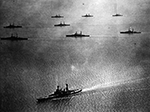 1.60k | U.S. Navy Battle fleet steaming into Panama Bay to join scouting fleet for combined fleet maneuvers, probably 1923. | The irony of this photo is that the ship with the least certain ID is the one closest to the camera! The probability is that she is the California (BB-44) based on the fact that the 3 Colorado class (BB-45 / 48) operated for such a short time without catapults and the ship in the photo has a bare quarterdeck). The photo is not clear enough to show twin or triple turrets. However, the ships in the background show enough unique characteristics to give more certainty about an ID. The nearest column are, left to right, Mississippi (BB-41) (uneven lookout station heights on the cagemasts), Tennessee (BB-43), (unique searchlight towers on after stack), and Idaho (BB-42) (lower bridge than New Mexico (BB-40)). The two ships in the second column are New York (BB-34) (bridge does not extend out far enough to be Texas (BB-35)) and Nevada (BB-36) (no enclosed lookout stations on the cagemasts and she has a catapult on her quarterdeck). The farthest column has (again left to right) Arizona (BB-39) (lower bridge), Pennsylvania (BB-38) (higher bridge) and New Mexico (again, the higher bridge). It is interesting that the only apparent catapult is the one on the Nevada. This would place the photo in the 1922-24 time frame. Ernest La Rue Collection, Gift of the U.S. Army. Courtesy of the Library of Congress. USN photo # Lot-11952-VI-37, courtesy of the National Museum of the U.S. Navy, courtesy of flickr.com. | Photo & text i.d. courtesy of Richard M. Jensen. 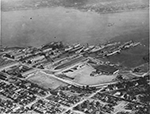 918k | View of the U.S. Puget Sound Navy Yard, Bremerton, Washington, in September 1924. Two battleships are visible, a Colorado-class (BB-45 / 48), left, and Tennessee class (BB-43 / 44). | National Archives Identifier: 6036982 |
Photo courtesy of catalog.archives.gov 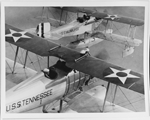 014339i 910k | Vought VE-9H floatplane and Vought OU-1. |
The aircraft from Milwaukee (CL-5) is a Vought VE-9H floatplane. The aircraft from Tennessee (BB-43) is a Vought OU-1. Photograph taken sometime during the nineteen-twenties. USN photo NH 72919 courtesy of history.navy.mil |  2.76k | U.S. Navy Vought UO-1 attached to the battleship Tennessee (BB-43) in flight. | USN photo courtesy of United States Navy Aircraft Since 1911 by Gordon Swanborough and Peter M Bowers via Robert Hurst.
| 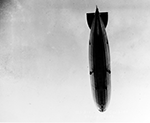 690k | The Shenandoah (ZR-1) in flight, circa 1924, during operations with the U.S. Fleet. Photographed by Browne, from the foredeck of Tennessee (BB-43). Note fire control arrangements on the battleship, among them the rangefinder atop the pilothouse and the foremast concentration dial.
|
USNHC photo (Insert) # NH 80545, courtesy of the Naval Historical Foundation. Collection of Captain Frank Brooks Upham. | USN photo # 80-CF-14-2054-9, from the National Museum of the U.S. Navy via flickr.com.  782k |
The Shenandoah (ZR-1) flies over the Tennessee (BB-43). |
Photo from the James R. Nehez, Sr. collection, courtesy of James R. Nehez, III. |
 256k |
Tennessee (BB-43) & the Langley (CV-1) traverse the Panama Canal in the Pedro Miguel (Miraflores) Locks. |
The tell-tale signs on the Tennessee are the AA battery and the secondary main battery range finder on the No. 2 Turret. I have a source which states that the secondary main battery range finder (the primary is atop the bridge) was moved from the top of Turret No. 3 to No 2 when the Type "P" catapult was added atop No. 3. By the mid 30's (exact date unknown), this rangefinder is gone. This would be around 1924 or early 1925. In 1922 the two after 5"/51 "wet" mounts on the 02 deck were replaced by 4 3"/50 AA guns. In 1928 this battery was replaced with 8 5"/25 arranged 3 guns aft of the boat davits P&S and 1 forward of the boats but aft of the forward 5"/51 "wet" mount all on the 02 deck. What I see is the a rangefinder on the No. 2 Turret and two AA gun barrels pointing outboard abaft the boats. This together the full decked Langley gives us a rough range of 1925-1937. The questions now becomes whether the AA guns are 3" or 5". I can distinguish the 5"/51 gun forward on the 02 deck. I cannot distinguish the taller and bulkier form of a 5"/25 which should be directly abaft of it if this is post-1928. Add to that, to my eye, the AA gun barrels look too long for the snub-nosed 5"/25's. Unfortunately none of the 5"/51 are pointed out board for comparison. My opinion: 1925-1928. USN photo courtesy of Paul & Barbara Rebold. Photo i.d. & text courtesy of Chris Hoehn. | 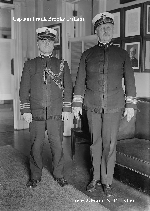 154k |
Captain Frank Brooks Upham commanded the battleship Tennessee (BB-43) from September 1924 to March 1926. He stands alongside of R. Admiral N.R. Usher. | Digital ID: ggbain # 30567. Source: Library of Congress Prints and Photographs Divisio, courtesy of Bill Gonyo. | 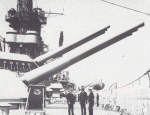 47k |
View of the Quarter deck. Left to right: Captain Frank Brooks Upham & Cmdr J.N. Ferguson. Note the markings on the main battery. |
USNHC # NH 80554, courtesy of the Naval Historical Foundation. Collection of Captain Frank Brooks Upham. |
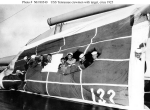 93k |
Tennessee (BB-43) crewmen pose with a well-hit target, after main battery gunnery practice in about 1925.
|
USNHC # NH 80540, courtesy of the Naval Historical Foundation. Collection of Captain Frank Brooks Upham. |
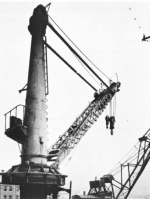 43k |
One of Tennessee's (BB-43) boat cranes. Sitting on the deck beyond is one of the 5in/51 secondary battery and behind that is a 3 inch anti-aircraft gun. |
USN photo and text courtesy of Warships in Profile, Volume 2, by John Wingate, Profile Publications LTD, Windsor, Berkshire, U.K. |
 014295 548k |
Panorama of Sydney Harbour during the United States Navy's goodwill tour. |
On 23 July 1925, Sydney hosted eight of the US Navy Battle Fleet's largest ships, including California (BB-44), Colorado (BB-45),Tennessee (BB-43), Maryland (BB-46), West Virginia (BB-48), New Mexico (BB-40), Mississippi (BB-41) and Idaho (BB-42). The fleet departed for New Zealand on 6 August. This photograph was probably taken at Georges Head Battery, in Georges Heights in the Sydney suburb of Mosman. This photo is part of the Australian National Maritime Museum’s Samuel J. Hood Studio collection. Sam Hood (1872-1953) was a Sydney photographer with a passion for ships. His 60-year career spanned the romantic age of sail and two world wars. The photos in the collection were taken mainly in Sydney and Newcastle during the first half of the 20th century. The ANMM undertakes research and accepts public comments that enhance the information we hold about images in our collection. This record has been updated accordingly. Image and text provided by flickr.com |
 37k |
Night time stern view of the Tennessee (BB-43), Mississippi (BB-41), California (BB-44) and or Idaho (BB-42) in Port Jackson, Sydney, Australia, 1925. |
This photo is part of the Australian National Maritime Museum's Samuel J. Hood Studio Collection in Flicker. | Sam Hood (1870-1956) was a Sydney photographer with a passion for ships. His 72-year career spanned the romantic age of sail and two world wars. The photos in the collection were taken mainly in Sydney and Newcastle during the first half of the 20th century and submitted via Pieter Bakkels & Bill Gonyo.  1.90k |
Port Angeles Washington: The lack of turret bearing markings places the photo post 1924 while the already noted presence of the Kidder (DD-319) places it before 1930. The front row of battleships are, left to right, Colorado (BB-45) based on the turret two rangefinder, West Virginia (BB-48) based on the lack of a turret two rangefinder, and probably California (BB-44) based on the bridge configuration. The back row, left to right, are New Mexico (BB-40) based on the higher bridge configuration, Mississippi (BB-41), based on the lower bridge and the fact that the searchlights and lookout station on the main mast are lower than those on the foremast (BB-42 had them at the same height), and Maryland (BB-46) based on the configuration of the turret two rangefinder. |
Photo courtesy of Curtis Nicolaisen. | Photo & text i.d. courtesy of Richard Jensen. 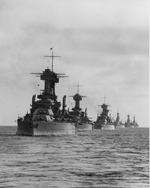 1.22k | The United States Battle Fleet steaming in column off the California coast during the middle or later 1920s. The three leading ships are (in no particular order) Colorado (BB-45), Maryland (BB-46) and West Virginia (BB-48) followed by Tennessee (BB-43) and three older battleships. Photograph taken from California (BB-44). | Official USN photo Naval History and Heritage Command # 80-G-695093, now in the collections of the National Archives. | 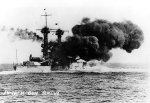 96k |
Firing her 14"/50 main battery, during gunnery practice in the 1920s. |
Official USN photo USNHC # NH 84665, now in the collections of the National Archives. |
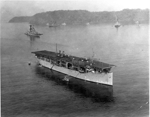 2.44k |
Langley (CV-1) with Vought VE-7 aircraft on deck, at anchor off Culebra Island, Puerto Rico on 18 March 1926. In the background are 4 four-stack destroyers and a Tennessee class (BB-43 /44) battleship on the left, and two New Mexico (BB-40 /42) class battleships (center and right). |
At the time, the Tennessee's are hard to tell apart. A few years later, Tennessee (BB-43) had the open bridge added around her pilothouse, and even later, California (BB-44) added the enlarged flag bridge. But in the 1922 (or so) period, they were close in config. The New Mexico's appear to be Mississippi (BB-41) on the left (or in the center) and New Mexico (BB-40) (nearly bow-on) on the right. The original photo was labeled "Harbinger" to show symbolically how the unimposing Langley was the first of a line of ships which eventually drove the battleship from its primary place into the background. Photo i.d. & text in italics courtesy of Richard Jensen. | USN photo via collections.naval.aviation.museum.  709k | Different angle of the above photo: Langley (CV-1) & Battleships at anchor off Culebra Island, Puerto Rico, 18 March 1926. | USN photo NARA II 80-G-185902 via courtesy of Tracy White @ Researcher @ Large.
| 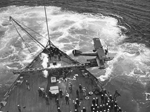 180k |
A Vought UO-1 taking off from the stern of the Tennessee (BB-43) on 6-3-26. |
Text i.d. courtesy of Alan Moore. | USN photo courtesy of Paul & Barbara Rebold. 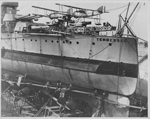 014320r 660k |
Entitled San Francisco Bay's Dry Docks Can Take Care of Leviathans. Stern of Tennessee (BB-43) in drydock at Hunters Point, 1926. Two Vought UOs are on the catapults. |
Photo courtesy of David Wright. |
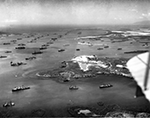 2.60k |
Ships of the U.S. Fleet pictured at anchor at Guantanamo Bay, Cuba, during winter exercises in 1927. |
The "center" row has Mississippi (BB-41) then Langley (CV-1), Oklahoma (BB-37), Pennsylvania (BB-38) and Arizona (BB-39) in that order. The next row to the left has Idaho (BB-42) then New Mexico (BB-40), followed by 3 of the Tennessee/Colorado class (hard to pick out distinguishing features in this photo), with Nevada (BB-36) as tail-end-Charlie. Further to the left are another Tennessee/Colorado class BB and a Memphis (formerly Tennessee) class armored cruiser. Two unidentified Omaha class cruisers are in the foreground. There are at least 17 destroyers, identifiable (bottom, right) is Mahan (DD-102), converted to a minelayer and redesignated DM-7, but still wearing her old DD hull number (102) and two submarine tenders in the foreground with about 10 smaller and two large submarines. The peninsula in the right foreground is South Toro Cay, where the drydock is still visible that was begun in 1904, but cancelled two years later. Photo i.d. courtesy of Richard Jensen & wikipedia.org. | Photo courtesy of wikipedia.org via Branden Deschaine & Fabio Pena  206k |
Tennessee (BB-43) & the Langley (CV-1) traverse the Panama Canal in the Pedro Miguel (Miraflores) Locks. |
From what Chris explains, and if we take into account the relatively large number of planes aboard Langley (a consequence of CAPT Reeves being Commander, Aircraft Squadrons, Battle Fleet) and the fact that the ships are bound for the Pacific, a plausible date is circa March 1927, when the Battle Fleet returned to the West Coast after Fleet Problem VII. USN photo courtesy of Fabio Pena. |
 667k |
Tennessee (BB-43) & maybe California (BB-44) seem ready to solve a Fleet Problem. |
Photo courtesy of Arnie Putnam. |
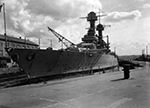 500k | Tennessee (BB-43) in dry-dock at the Bremerton Navy Yard, Bremerton, Washington, 12 September 1928.
| USN photo # 80-CF-14-2054-9, from the National Museum of the U.S. Navy via flickr.com. | 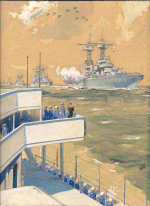 122k | Watercolor of a Presidential review during President Hoover's term of office, 1928-32. | Crews line the rails of a Colorado class (BB-45 / 48) battleship as the ships pass in line astern of the reviewing stand with the airship Los Angeles (ZR-3) piercing the clouds accompanied by 9 biplanes. Courtesy of Michael Schwarz.
| 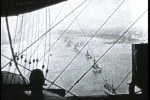 56k | View of the U.S. Battle-fleet from above, possibly from the airship Los Angeles (ZR-3). | Photo courtesy of periscopefilm.com. |
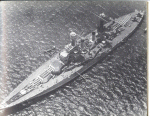 703k |
Tennessee (BB-43), in March 1930. |
Official USN photo # 80-G-466154, now in the collections of the U.S. National Archives. |
 60k |
The Tennessee (BB-43) in 1930, line drawing by A. L. Raven. |
Photo and text courtesy of U.S. Battleships: An Illustrated Design History by Norman Friedman. | 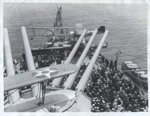 193k |
Memorial services aboard the battleship Tennessee (BB-43), 13 June 1931. |
As if to symbolize that those who lived would carry on, these guns and airplanes aboard the ship offered a picturesque setting for memorial services recently aboard the battleship as she lay in L.A. harbor San Pedro, CA., The ceremonies were held under the auspices of the American Legion of San Pedro with Captain C.E. Courtney, Commander of Tennessee officiating. © Associated Press Photo courtesy of San Francisco Examiner via David S. Smith. | 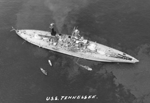 269k | The top turret of Tennessee (BB-43) is marked with a (43) as she lays with a slight wisp of smoke in oil slicked waters. | USN photo courtesy of Scott Koen & ussnewyork.com. |
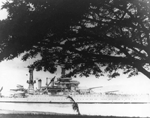 126k | The Tennessee (BB-43) passes a tree in a photo reminiscent of Tai Sing Loo. | USN photo courtesy of Scott Koen & ussnewyork.com. |
 413k | New York (BB-34) ahead of Pennsylvania (BB-38). The next ship ahead is a Tennessee class (BB-43 /44) based on the slope of the turret roofs. (Uniform slope back to front - no kink like the twin 16" mounts on the Colorado's (BB-45). Based on the relatively full appearance of the forward superstructure, I am leaning toward California (BB-44) which had an enlarged flag bridge as Battle Force Flagship. The other three are obviously Tennessee (BB-43) and/or Colorado class (BB-45 / 48) but are too indistinct to ID specifically. Because of the boom cranes on the sterns, the photo was taken between 1931 and 1934. | Photo courtesy of Kerry Garrett. | Photo & text i.d. courtesy of Richard M. Jensen. 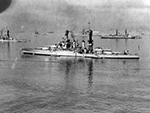 714k | Tennessee (BB-43), anchored off Panama, 7 February 1929. | USN photo # 80-CF-14-2054-7 from the National Museum of the U.S. Navy, courtesy of flickr.com. | 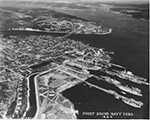 638k | View of the U.S. Puget Sound Navy Yard, Bremerton, Washington, in 1932, Identifiable ships include (front to back): the crane ship Kearsarge (AB-1); (probably) a Tennessee class (BB-43 / 44), two Eagle-class patrol craft; Arkansas (BB-33); three Clemson/Wilkes-class destroyers; & Lexington (CV-2). | Photo i.d. via commons.wikimedia.org. |
National Archives Identifier: 6036984 Photo courtesy of catalog.archives.gov 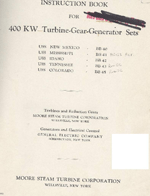 88k |
Four photos for the 1933 400 KW Turbine Gear Generator Sets for the battleships: | New Mexico (BB-40), Mississippi (BB-41), Idaho (BB-42), Tennessee (BB-43) & Colorado (BB-45). Figure 1 Figure 2 Figure 5 Figure 4 Photos courtesy of Ed Zajkowski. | 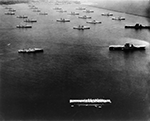 2.44k | Ships of the United States Fleet pictured at anchor inside the breakwater at Colon, Canal Zone, 1935. | The carriers are, front to back, Langley (CV-1), Saratoga (CV-3) and Lexington (CV-2). The two battleships beyond Lexington are the New York (BB-34) with Texas (BB-35) behind. The nearest battleship, straight up from the Langley is Pennsylvania (BB-38). The BB immediately beyond and to the left of Pennsylvania (BB-38) is California (BB-44). The remaining battleships include two New Mexico's: Mississippi (BB-41) and Idaho (BB-42) , but even this higher rez shot is not clear enough to tell which is which. Also are the rest of the "Big Five" and what is probably one of the Nevada's, but that is not certain. The photo is not clear enough for positive identifications. The cruisers to the left are three Northampton's (CA-26 / 31) and the two Pensacola's (CA-24 & 25) (the pair furthest from the camera) and six Omaha's. Photo & text i.d. courtesy of Richard M. Jensen. | Photo courtesy of National Naval Aviation Museum (NNAM) photo (# 1996.488.001.006) courtesy of Fabio Pena. 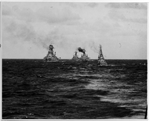 013987 900k | The Arizona (BB-39) (L) with (L-R), Tennessee (BB-43), Nevada (BB-36) and Brant (AM-24) en route to Hawaii for fleet maneuvers, 1935. | Photo NH 50258, courtesy of history.navy.mil
|
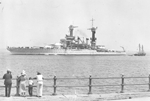 475k |
California (BB-44) or Tennessee (BB-43) visits the Boston Navy yard, circa mid 1930's. |
Photo 08_06_022495 courtesy of the Boston Public Library, Leslie Jones Collection via Sean Hert & flickr.com. | 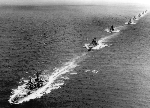 272k | The West Virginia (BB-48) as flagship for the Commander, Battleship Divisions, Battle Fleet, followed by other battleships steaming in line ahead during the middle through later 1920's. | The aircraft on the turret catapult appears to be a Curtiss SOC (I can't make out the stern aircraft.), so the date has to be mid-to-later 1930s. The four leading ships behind her are (in no particular order) Colorado (BB-45), Maryland (BB-46), California (BB-44) & Tennessee (BB-43). Text i.d. courtesy of Alan Moore. |
Photo courtesy of Pieter Bakels. 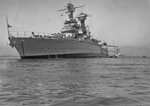 014337 2.32k | Battleship Tennessee (BB-43) Liszt in Naval Test of Torpedo Damage Control: Should she ever be torpedoed, the Tennessee might appear as in this exclusive picture taken at her San Pedro anchorage yesterday while naval officers tested damage control. Water was pumped into the starboard tanks, listing the vessel as it might if hit directly by a torpedo. The great ship resumed an even keel when the extra ballast was pumped out. The flag is at half-staff for the late George H. Dern, Secretary of War. |
Note the Colodado class battleship to stern. Times photo, Los Angeles Times, 28 August 1936, courtesy of digital.library.ucla.edu |  014443c 674k | US battleships at anchor, Long Beach. |
Photo courtesy of meisterdrucke.uk |  1.15k |
Sailing the Tennessee (BB-43), circa 1936-39. |
Photo I.d. courtesy of Richard M. Jensen. |
Photo courtesy of Ric Hedman via Kellie Chandler via David Tinkle FCS/1c SS, Salmon (SS-182). 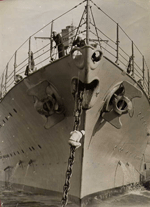 141k |
One of Tennessee's (BB-43) crewmen ascending or descending the anchor chain, 1937. |
© Associated Press Photo courtesy of San Francisco Examiner via David S. Smith. | 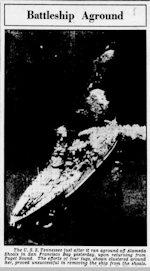 NR |
Battleship Aground |
The Tennessee (BB-43) just after it ran aground off Alameda Shoals in San Francisco Bay yesterday, upon returning from Puget Sound. The efforts of four tugs, shown clustered around her, proved unsuccessful in removing the ship from the shoals. Copyright. A. P. Wirephoto. | Image provided by: Library of Congress, Washington, DC. Photo & text by Evening Star. [volume] (Washington, D.C.) 1854-1972, 12 June 1937, Image 9, courtesy of chroniclingamerica.loc.gov. 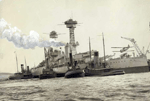 152k |
Tugs help to push the Tennessee (BB-43) from being stuck in mud flats, 1937. |
© Associated Press Photo wire photo courtesy of San Francisco Examiner via David S. Smith. | 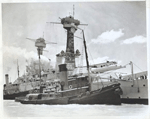 173k |
The tug boat Sea King rounds the stern of the grounded Tennessee (BB-43) in an attempt to push her off the mud flats, 1937. |
© Associated Press Photo courtesy of San Francisco Examiner via David S. Smith. | 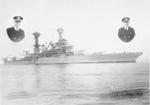 252k |
The Tennessee (BB-43) Communication Dept. group photo, 1937, Bremerton, Washington. Five page PDF. |
Photos courtesy of Greg Alexander. |  957k |
Pre war bow & starboard quarter & broadside views of the Tennessee (BB-43). |
Photo from the collection of Carrie Schmidt. |
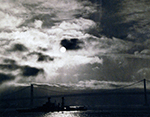 982k | Tennessee (BB-43) with San Francisco Bridge in the background, 13 July 1938. Photographed by aircraft from Ranger (CV-4). | USN photo # 80-CF-14-2054-12, from the National Museum of the U.S. Navy via flickr.com. |  183k |
Tennessee's (BB-43) band poses for a group shot in her mid life era. |
USN photo courtesy of Robert M. Cieri. | 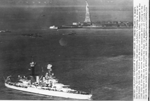 531k |
N.Y., 13 April 1939. "Guardian of liberty passes its symbol." |
Majestic in dawn's early light, the battleship Tennessee (BB-43), Rear Admiral A.E. Watson's flagship is shown as she steamed into N.Y. harbor past the Statue of Liberty today. Tennessee is the first ship of the line to arrive for review in connection of the opening of the N.Y. World's Fair. She will rejoin the Fleet for maneuvers off Virginia capes, then join the parade up the Atlantic coast to N.Y. A.P. Wirephoto from the collection of Michael Strout, courtesy of Jonathan Eno. | 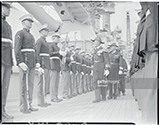 322k | (Original Caption) New York: Norse Prince Inspects The Marines: Wearing the uniform of an admiral of the Norwegian Navy, Crown Prince Olav, nearest camera, is pictured as he inspected the marine Guard of Honor aboard the battleship Tennessee (BB-43), in the Hudson River, off New York City, 13 April 1939. The Prince visited the battlewagon to pay his respects to Rear Admiral A. E. Watson, (behind him), and other fleet officers. The Crown Prince and Crown Princess Martha arrived in the United States last week. | Photo by Bettmann/Getty Images courtesy of gettyimages.com.
| 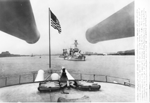 177k | N.Y. 29 April 1939. "Fleet steams up Hudson". | Thirty seven vessels of the Atlantic Squadron steamed through N.Y. harbor and up the Hudson River today as part of the ceremonies connected with tomorrow's opening of the World Fair. This striking picture made from the deck of the New York (BB-34) flagship, shows the Texas (BB-35) followed by the Tennessee (BB-43). A.P. Wirephoto from the collection of Michael Strout, courtesy of Jonathan Eno. | 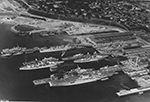 465k | View of the U.S. Puget Sound Navy Yard, Bremerton, Washington, in 1940. Identifiable ships include (front to back): the aircraft carrier Lexington (CV-2); a New Orleans-class heavy cruiser; a Tennessee class (BB-43 / 44) battleship (left); a Nevada-class (BB-36 / 37) battleship; a Brooklyn-class light cruiser; two Farragut-class destroyers; a Northampton-class heavy cruiser is in a drydock; one of the destroyers in the foreground is probably Charles F. Hughes (DD-428) which was built at the Puget Sound Naval Shipyard and commissioned on 5 September 1940. The other could be Monssen (DD-436), commissioned on 14 March 1941. The construction of Drydock No. 5 was started in the background. | National Archives Identifier: 6036986 |
Photo courtesy of catalog.archives.gov  157k |
Curtiss SOC-3 scout-observation floatplanes parked on the after catapult of Tennessee (BB-43), 1940 on the Hudson river. |
USN photo courtesy of Myron J. Smith Jr, from his book "Volunteer State Battlewagon", from Pictorial Histories Publishing, Missoula, Montana. |
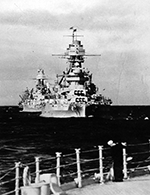 486k | Arizona (BB-39) leading Nevada (BB-36) and the Tennessee (BB-43) and a New Mexico class battleship underway.
| USN photo # 80-G-456504 from the National Museum of the U.S. Navy via flickr.com.
|  2.10k | Tennessee (BB-43) sails the bay with part of her crew lined up for inspection on the starboard side. | USN photo courtesy of Jim Millholland via Alan Cole.
| 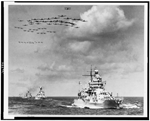 463k | Probable front and rear photos here and below showing formations of aircraft flying over U.S. Navy battleships during exercises at sea, 1938 / 1939. |
Pictured here is the New Mexico (BB-40) in the van with other battleships of the Pacific Fleet and a carrier air group, led by the Air Group Commander in a Curtiss SBC Helldiver. The aircraft following are: A torpedo squadron of eighteen Douglas TBD-1s; A bombing squadron of eighteen Northrop BT-1s; A scouting squadron eighteen Curtiss SBCs; A fighting squadron of eighteen Grumman F2F-1s or F3F-3s from either the Yorktown (CV-5) or F3F-2s from the Enterprise (CV-6), plus possibly nine additional aircraft. The Yorktown and Enterprise were the only two carriers whose bombing squadrons were equipped with the Northrop BT-1. The text for the photo reads: "The Navy uses enormous amounts of rubber. At least seventy-five tons of rubber, enough to makes 17,000 tires, are used in the construction of each of these battleships. Tons more are needed for the naval planes that are making history over the world. Medical and communication requirements--and countless other needs of the Navy--are met." The lead BB looks like Mississippi (BB-41) followed by Maryland (BB-46) (rangefinder on Turret II). My first impression of the Tennessee class (BB-43 /44) is the Tennessee (BB-43), but that is not a certain ID from this photo alone. Fourth is the Oklahoma (BB-37) (no birdbath). Aside from the DD now in the lead, I see nothing in the head-on shot aerial that positively differs from the ID's of the first 4 BB's in the first photo. Of course, in the aft aerial shot, BB #5 is the California (BB-44), ID'd by the enlarged flag bridge, lending support to BB #3 in the first photo being Tennessee. Everything I see supports these three photos all being part of the same operation with at least the first 5 BB's remaining in the same order. Photograph # LC-USE64 - DC-000944 & partial text courtesy of memory.loc.gov. |
Battleship i.d. & text courtesy of Richard Jensen. Aircraft i.d. & text & timeline courtesy of Alan Moore via the following sources: Airplane i.d.: Yorktown Class Carriers (Warship Pictorial No. 9) by Steve Wiper, Tucson, AZ: Classic Warships Publishing, 2000. & That Gallant Ship: U.S.S. Yorktown (CV-5) by Robert Cressman, Missoula, MT: Pictorial Histories Pub Co, 1985. Timeline from Battleship Arizona: An Illustrated History by Paul Stillwell, Annapolis, MD: Naval Institute Press, 1991. 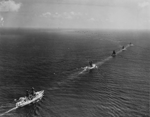 1.62k | Probable front and rear photos here and above showing formations of aircraft flying over U.S. Navy battleships during exercises at sea, 1938 / 1939. | New Mexico (BB-40) is leading the BB column while the remaining battleships have dual masthead fire control structures. The air group formation in the two photos appears to be similar. The composition of 18 TBDs, 18 BT-1s, 18 SBCs, and 27 fighters is easier to distinguish in the front/surface view. I'm assuming, based on total aircraft count alone, that the formation in the rear/aerial view is the same. (The perspective makes it difficult to sort the monoplanes and biplanes into their respective types.) The only difference is that in the front/surface view the formation is lead by a Curtiss SBC Helldiver (likely the Air Group Commander) but in the rear/aerial view that lead Helldiver is not present. I suppose it's possible that the photographer was in that Helldiver's rear seat. What stands out for me is the presence of nine extra fighters beyond the normal squadron composition of 18, as seen in the other three squadrons in this formation. Photo i.d courtesy of Chuck Haberlein, Richard Jensen, Aryeh Wetherhorn, & Tracy White @ Researcher @ Large. | Battleship i.d. & text courtesy of Richard Jensen. Aircraft i.d. & text courtesy of Alan Moore. US Navy and Marine Corps Museum/Naval Aviation Museum, photo No. 2008.104.001.234. 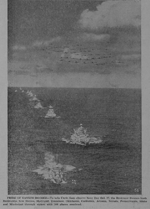 01yankeedoodle 441k |
PRIDE OF YANKEE DOODLE-To help Uncle Sam observe Navy Day, 27 October 1939: the Destroyer Downes (DD-375) leads Battleships New Mexico (BB-40), Maryland (BB-46), Tennessee (BB-43), Oklahoma (BB-37), California (BB-44), Arizona (BB-39), Nevada (BB-36), Pennsylvania (BB-38), Idaho (BB-42) and Mississippi (BB-41) through waters with 100 planes overhead. |
Photo courtesy of umich.edu |
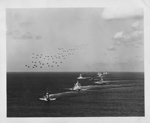 1.31k | Between 9 & 13 September 1940 the Arizona (BB-39) was under way with other ships of the US Fleet for simulated fleet engagement. She is pictured here in company with other ships of the Pacific Fleet taken during Fleet Ops. and at least one carrier air group. | Scanned from: "The Fleet Today" by Kendall Banning. Funk & Wagnalls Company, N.Y. and London, 1942. Submitted by Pieter Bakels. | Text & photo i.d. courtesy of Alan Moore via Battleship Arizona: An Illustrated History by Paul Stillwell, Annapolis, MD: Naval Institute Press, 1991.  70k | Captain Jonas H. Ingram commanded the battleship Tennessee (BB-43) from July 1940 to December 1940.
| Photo from the Harry S. Truman Presidential Library & submitted by Bill Gonyo. |
 013600b 1.15k | Painting by the artist Joseph Reindler titled SOMEWHERE OFF HONOLULU : Heavy elements of the US Pacific Fleet on maneuvers; Nevada (BB-36) leads Maryland (BB-46) (second-nearest) and Tennessee (BB-43) (at distance). Another generic scene, circa Winter 1941. | Besides Nevada, details of armament coupled with nuances of the Measure-1 camouflage worn by these ships, as well as the obvious lines of anti-torpedo blisters also permit clear identification of Maryland at least – given that of the 16-inch gunned latter three of the ‘Big-5’ standard battleships, West Virginia (BB-48) was not fitted with anti-torpedo blisters by Winter of 1941; and Colorado (BB-45) was in refit at the time represented by this drawing. Admittedly there was very little I could add on so small a sketch to differentiate between Tennessee and her sister California (BB-44). The International Code of Signals still reads well in black & white – which is by design not accident; thereby the signal Nevada makes at her Starboard foretop signals yard reads : “PREP-BAKER-TARE, FIRST-REPEAT-LOVE-ZED, X-RAY-ONE-SEVEN-NINE”. Or, translated: “TOGETHER TURN TO COURSE TRUE ONE-SEVEN-NINE”. It was a bit of fun working an actual message into so small a drawing. Of course with the signal still hauled up Nevada has yet to actually execute her own turn – and with Maryland and Tennessee in line astern still wearing around onto the same heading the scene would no doubt make for some fun between the respective Officers of the Deck and Signals Yeomen in all three ships. But no doubt with war brewing all crews were being put through their paces. Painting courtesy of Joseph Reindler. | Attack on Pearl Harbor |
 2.94k |
Japanese Attack on Pearl Harbor, 7 December 1941. Imperial Japanese Navy aircraft carriers in dawn fly-off for Pearl Harbor. |
Artwork by John Hamilton from his publication, "War at Sea," pg. 68-69. | USN photo # 80-142-H, courtesy of the U.S. Navy Art Gallery from the National Museum of the U.S. Navy, courtesy of flickr.com. 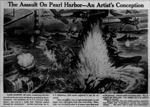 014325 NR |
The Assault On Pearl Harbor—An Artist's Conception |
HANK BARROW, AP artist, reconstructs the battle at Pearl Harbor from information provided by Secretary Knox. One battleship, the Arizona (BB-39), (right center), was sunk by a bomb that "literally passed through the smokestack." Another battleship, the Oklahoma (BB-37), (left center,capsized. It can be repaired. Three destroyers (one in right foreground), an old target ship, and a mine layer also went down. Other ships were damaged, many U. S. planes were destroyed on the ground. Almost 2,900 servicemen died The attackers lost three subs (one midget sub is at extreme right) & 41 aircraft. Knox said that after the initial surprise, American men fought with "magnificent courage and resourcefulness. The men's will to resist was tremendous... Image and text provided by University of Florida. | Photo from The Key West Citizen. [volume] (Key West, Fla.) 1879-current, 22 December 1941, Image 1, via chroniclingamerica.loc.gov. 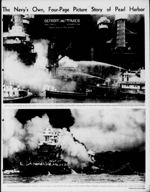 014316s 2.14k |
The Navy's Own, Four-Page Picture Story of Pearl Harbor |
Old Glory flying proudly in one of her darkest hours and over sailors at Pearl Harbor last 7 December risking their lives close up to the bomb-set flames roaring from both West Virginia (BB-48) and Tennessee (BB-43). Slightly-damaged 31,000-ton Maryland (BB-46) (first battleship to rejoin the fleet after repairs) in Pearl Harbor's flames. Behind her is another battleship, at right the capsized battleship Oklahoma (BB-37). Image and text provided by Central Michigan University, Clark Historical Library. | Photo from Detroit Evening Times. (Detroit, Mich) 1921-1958, 06 December 1942, FINAL, Images 21, 22, 23, & 24, via chroniclingamerica.loc.gov.  1.67k |
Battleship row in flames. |
Artwork by John Hamilton from his publication, "War at Sea," pg. 74-75. | USN photo # 80-142-I, courtesy of the U.S. Navy Art Gallery from the National Museum of the U.S. Navy, courtesy of flickr.com. 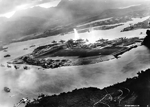 399k |
Photograph taken from a Japanese plane during the torpedo attack on ships moored on both sides of Ford Island shortly after the beginning of the Pearl Harbor attack. View looks about east, with the supply depot, submarine base and fuel tank farm in the right center distance. A torpedo has just hit West Virginia (BB-48) on the far side of Ford Island (center). Other battleships moored nearby are (from left): Nevada (BB-36), Arizona (BB-39), Tennessee (BB-43) (inboard of West Virginia), Oklahoma (BB-37) (torpedoed and listing) alongside Maryland (BB-46), and California (BB-44). On the near side of Ford Island, to the left, are light cruisers Detroit (CL-8) and Raleigh (CL-7), target and training ship Utah (BB-31) and seaplane tender Tangier (AV-8). Raleigh and Utah have been torpedoed, and Utah is listing sharply to port. Japanese planes are visible in the right center (over Ford Island) and over the Navy Yard at right. U.S. Navy planes on the seaplane ramp are on fire. Japanese writing in the lower right states that the photograph was reproduced by authorization of the Navy Ministry. |
Text courtesy of wikipedia.com. | Official USN photograph NH 50930. 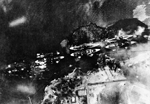 3.95k |
Vertical aerial view of "Battleship Row", beside Ford Island, during the early part of the horizontal bombing attack on the ships moored there. Photographed from a Japanese aircraft. Ships seen are (from left to right): Nevada (BB-36), Arizona (BB-39) with Vestal (AR-4) moored outboard; Tennessee (BB-43) with West Virginia (BB-48) moored outboard; Maryland (BB-46) with Oklahoma (BB-37) moored outboard; and Neosho (AO-23), only partially visible at the extreme right. A bomb has just hit Arizona near the stern, but she has not yet received the bomb that detonated her forward magazines. West Virginia and Oklahoma are gushing oil from their many torpedo hits and are listing to port. Oklahoma's port deck edge is already under water. Nevada has also been torpedoed. |
Japanese inscription in lower left states that the photograph has been officially released by the Navy Ministry. Also at NHHC as NH 50472. From the translated Japanese caption, "Alas, the spectacle of the American battleship Fleet in its Dying Gasp. The attack of our assault force was extremely accurate and achieved direct hits with all bombs. The leading ship of the Oklahoma Class is already half sunk. The Maryland type and the Pennsylvania type are blowing up from several direct hits. The ships crumble and their hulls are twisted and keeling over. Crude oil gushes forth fearfully. This view of the wretched enemy's capital ships which were converted into a sea hell was photographed from directly overhead by the heroes of our calm, valorous attack force." USN photo # 80-G-30551, courtesy of the National Museum of the U.S. Navy, via flickr.com. |
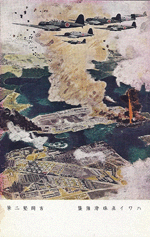 1.01k |
Japanese post card of bombers over Pearl Harbor, 7 December 1941. |
Photo courtesy of Arnold Putnam.
| 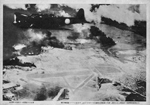 3.24k |
Japanese attack on Pearl Harbor - Hickam Field. |
Photo courtesy of Arnold Putnam.
| 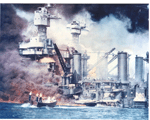 840k | Sailors in a motor launch rescue a survivor from the water alongside the sunken West Virginia (BB-48) during or shortly after the Japanese air raid on Pearl Harbor. Tennessee (BB-43) is inboard of the sunken battleship. Note extensive distortion of West Virginia's lower midships superstructure, caused by torpedoes that exploded below that location. Also note 5"/25 gun, still partially covered with canvas, boat crane swung outboard and empty boat cradles near the smokestacks, and base of radar antenna atop West Virginia's foremast. | National Archives Identifier: 12009098 | Local Identifier:111-C-5904 Photo courtesy of catalog.archives.gov 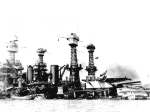 109k | Attack on Pearl Harbor, 7 December 1941: West Virginia (BB-48) sunk at anchor after her fires were put out. Her OS2U plane upside down on her deck with another plane burned out on the catapult. Tennessee (BB-43) is inboard. Note radar on West Virginia's foremast. | National Archives photo # 80-G-19945. | 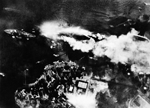 3.52k | Vertical aerial view of "Battleship Row", beside Ford Island, soon after Arizona (BB-39) was hit by bombs and her forward magazines exploded. Photographed from a Japanese aircraft. Ships seen are (from left to right): Nevada (BB-36); Arizona (burning intensely) with Vestal (AR-4) moored outboard; Tennessee (BB-43) with West Virginia (BB-48) moored outboard; and Maryland (BB-46) with Oklahoma (BB-37) capsized alongside. Smoke from bomb hits on Vestal and West Virginia is also visible. |
Japanese inscription in lower left states that the photograph has been reproduced under Navy Ministry authorization. Also at NHHC as NH 30552. Translated Japanese caption reads, "Capsizing, Sinking, Burning, the anchorage of the American capital ships is changed to a scene of carnage. In rapid succession, the enemy war vessels were set ablaze by the violent bombing attacks which followed the torpedo attacks. The special service ship in the capital ship anchorage has already been sunk. The violent smoke from the exploding powder magazine is rising from a vessel of the Oklahoma Class alongside. A Pennsylvania class ship, capsized and sinking, shows its bottom. Two ships the California class and the Maryland class are in flames from direct bomb hits. In the upper right-hand part of the photograph are what appear to be several rescue ships, darting right and left. USN photo # 80-G-30552, courtesy of the National Museum of the U.S. Navy, via flickr.com. |
 273k | Tennessee (BB-43) burning and damaged after the Japanese attack on Pearl Harbor, 7 December 1941. | USN photo # 80-G-32646, from the National Museum of the U.S. Navy via flickr.com. | 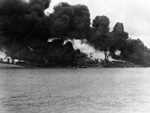 2.85k | View of Battleship Row during or immediately after the Japanese raid. West Virginia (BB-48) and Tennessee (BB-43) are in the center right. The capsized Oklahoma (BB-37) is at the left, alongside Maryland (BB-46). |
USN photo # 80-G-32416, courtesy of the National Museum of the U.S. Navy, via flickr.com. |
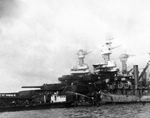 477k | West Virginia (BB-48) and Tennessee (BB-43) after the attack. | USN photo # 80-G-32475 from the National Museum of the U.S. Navy, courtesy of flickr.com.
| 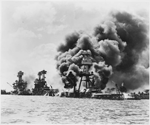 610k | Aftermath of the Japanese sneak attack on these three stricken U.S. battleships; from left to right: West Virginia (BB-48) (severely damaged), Tennessee (BB-43) (damaged), and the Arizona (BB-39) (sunk). | NARA #(NLR-PHOCO-A-65458) courtesy of fdrlibrary.marist.edu |
 86k |
Oil on canvas painting by the artist Tom Freeman entitled "Last Torpedo".
The Oklahoma (BB-37) starts to capsize.
The ship had no watertight integrity, as all portholes and watertight doors were open for Captain's inspection when the Japanese attacked.
Maryland (BB-46) is at left, and Tennessee (BB-43) is behind and to the left of the Oklahoma, and West Virginia (BB-48) is directly behind her and sinking. |
Photo and partial text courtesy of oldgloryprints.com |
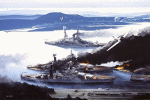 63k | Oil on canvas painting by the artist Ivan Berryman entitled "The Raid on Pearl Harbor, 7th December 1941 ", depicting the view across Battleship Row, viewed from above Ford Island as the Nevada (BB-36) gallantly makes her break for the open sea, coming under heavy attack from Japanese A6M2s from the carrier Hiryu. The Nevada was eventually too badly damaged to continue and was beached to avoid blocking the harbour entrance. In the immediate foreground, the lightly damaged Tennessee (BB-43) is trapped inboard of West Virginia (BB-48) which has sunk at her moorings, leaking burning oil and hampering the daring operations to pluck trapped crew members from her decks, while just visible to the right is the stern of the Maryland (BB-46) and the capsized Oklahoma (BB-37).
| Photo and partial text courtesy of military-art.com. |
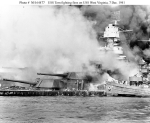 92k | With help from the crew of the Tern (AM-31), the fires aboard the sunken West Virginia (BB-48) are slowly being extinguished. Note radar antenna, paravanes and 16"/45 twin gun turrets on the battleship. | National Archives photo # NH 64477. | 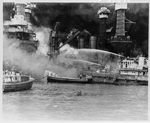 2.59k | This photo shows the fires being fought on the sunken battleship West Virginia (BB-48), 7 December 1941. The garbage lighter YG-17 is at right, with her crewmen playing two fire hoses at the flames. Assisting or standing by are a motor launch and an officer's motorboat. Tennessee (BB-43) is inboard of West Virginia . | An OS2U floatplane (marked "4-O-3") is upside down on West Virginia's main deck. A second OS2U is partially burned out atop the Turret # 3 catapult. Note radar antenna atop West Virginia's foremast. Official USN photo # 80-G-19947 courtesy of Bob Canchola, now in the collections of the National Archives. | 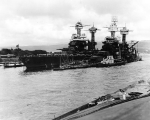 99k |
Tennessee (BB-43), at left, alongside the sunken West Virginia (BB-48), photographed from the capsized hull of Oklahoma (BB-37) on 10 December 1941, three days after the Japanese raid. The mainmast of Arizona (BB-39) is visible in the right distance. |
USNHC # NH 50770, now in the collections of the National Archives. |
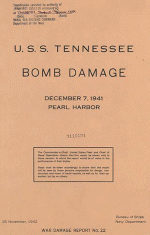 24k | Cover of the Bomb Damage - Pearl Harbor, December 7, 1941 Report of the Tennessee (BB-43). | Photo from WII War Damage Reports, courtesy of NavSea / dcfp.navy.mil, link submitted by Mike Green. | 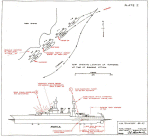 118k | Map I showing the location of the of the Tennessee (BB-43) and bomb impact damage during the attack on Pearl Harbor. | Photo from WII War Damage Reports, courtesy of NavSea / dcfp.navy.mil, link submitted by Mike Green. | 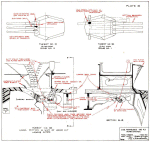 363k | Map II showing the location of the of the Tennessee (BB-43) and bomb impact damage during the attack on Pearl Harbor. | Photo from WII War Damage Reports, courtesy of NavSea / dcfp.navy.mil, link submitted by Mike Green. |  84k | Tennessee (BB-43) & Arizona (BB-39) with fires still burning. Note the fire hoses playing over the stern of Tennessee to wash burning oil away. | Photo from WII War Damage Reports, courtesy of NavSea / dcfp.navy.mil, link submitted by Mike Green. | 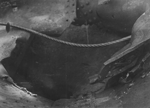 75k | Top of turret III looking down through the hole in the catapult at the opening through which the bomb penetrated. | Photo source "Seattle NARA, Puget Sound Naval Shipyard Ships files, 1940-50" submitted by Tracy White @ Researcher @ Large.
| 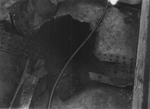 104k | Top of turret III showing the point of impact on plate "A". | Photo source "Seattle NARA, Puget Sound Naval Shipyard Ships files, 1940-50" submitted by Tracy White @ Researcher @ Large.
| 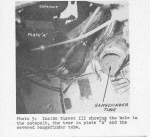 113k | Inside turret III showing the hole in the catapult, the tear in plate "A" and the severed rangefinder tube. | Photo from WII War Damage Reports, courtesy of NavSea / dcfp.navy.mil, link submitted by Mike Green. | 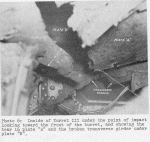 144k | Inside turret III under the point of impact looking forward th the front of the turret, and showing the tear in plate "A" and the broken transverse girder under plate "B". | Photo from WII War Damage Reports, courtesy of NavSea / dcfp.navy.mil, link submitted by Mike Green. | 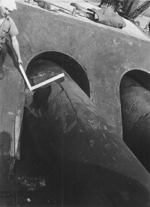 136k | Center gun of Turret II showing the hole gouged out by the bomb and the crack in "C" hoop. | Photo source "Seattle NARA, Puget Sound Naval Shipyard Ships files, 1940-50" submitted by Tracy White @ Researcher @ Large.
| 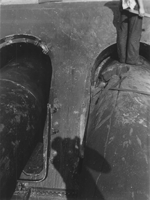 143k | Right and center gun of Turret II. Note the coaming around the right gun port partly blown off by the explosion. | Photo source "Seattle NARA, Puget Sound Naval Shipyard Ships files, 1940-50" submitted by Tracy White @ Researcher @ Large.
| Salvage & Repair |
 800k | Tennessee (BB-43) sometime after early February 1942 when her first post-Pearl Harbor mods were done.
| Wide World photo courtesy of David Buell.
| 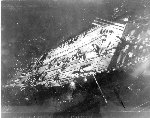 245k |
Tennessee (BB-43) overhead bow view. Puget Sound Navy Yard. 19 February 1942. |
USN photo # 398-42 courtesy of Pieter Bakels. |
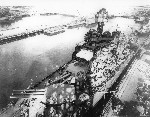 386k |
Tennessee (BB-43) at the Puget Sound Navy Yard on February 1942. Note that her cage-mainmast has been removed and that her 5-Inch guns have received splinter shields. |
The time to replace the mainmast was taken due to the fact that the ship had to have her main battery regunned; if it hadn't been for that, she would have had her mast cut down in a similar fashion to that of the Maryland (BB-46) and Colorado (BB-45). USN photo courtesy of Pieter Bakels. |
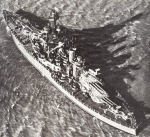 139k |
Tennessee (BB-43) before her major rebuild. |
Photo i.d. courtesy of Ron Balko & Ronald J. Nash. |
USN photo courtesy of "Warships in Profile, Volume 2," by John Wingate, Profile Publications LTD, Windsor, Berkshire, U.K. 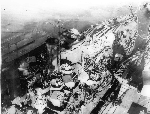 335k |
Overhead view, looking aft. Taken at Puget Sound Navy Yard on 19 February 1942 where she had her mainmast replaced by a tower structure that had already been fabricated before her arrival from Pearl Harbor. |
USN photo courtesy of Pieter Bakels. |
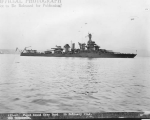 63k |
Tennessee (BB-43) at Puget Sound Navy Yard 26 February 1942 following her major refit. Note the barrage balloons over the harbor. |
USN photo courtesy of Seattle NARA # RG-181, submitted by Tracy White @ Researcher @ Large.
| 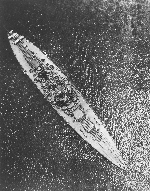 900k |
The overhead view shows the ship in June, 1942 entering San Pedro Harbor and shows the addition of two quadruple 1.1"/75 caliber A.A. mounts in place on the main deck just forward of #3 turret. |
National Archives photo # N-3141A, courtesy of David Buell. |
 44k |
From 20 June 1942 until 6 March 1944, Commodore Robert Stevenson Haggart was in command of Tennessee (BB-43). Under his command the Tennessee moved early in June, 1943 to Aleutian waters where it held extensive patrols in the northern waters. The following months, the ship sailed to Kiska as one of the vessels of the softening up bombardment, and when the troops were landed, the ship returned undamaged. Tennessee then participated in the Gilberts, Tarawa, Kwajalein and Marshall Islands Operations during World War II. For his service as commanding officer of Tennessee during the assault and capture of Eniwetok Atol, Marshall Islands, from February 17 to 23, 1944, he received a Letter of Commendation from the commander-in-chief, Pacific Fleet, with authorization to wear the commendation ribbon. He was also entitled to the Naval Unit Commendation awarded the officers and men of Tennessee.
|
Photo from the San Diego Navy Historical Association via Bill Gonyo. | 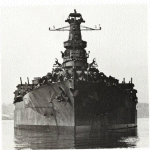 40k |
This view from dead ahead shows how the additional blisters to Tennessee's (BB-43) sides were added during rebuild in 1942-43 were faired into the bows. |
USN photo and text courtesy of "Warships in Profile, Volume 2," by John Wingate, Profile Publications LTD, Windsor, Berkshire, U.K. |
 92k |
Drawing prepared by the Bureau of Ships for Camouflage Measure 32v1, Design 1D intended for the battleship Tennessee (BB-43), circa 1943.
This plan shows the ship's starboard side and exposed decks.
|
Official USN photo # 80-G-157055, now in the collections of the National Archives. |
 58k |
Drawing prepared by the Bureau of Ships for Camouflage Measure 32v1, Design 1D intended for the battleship Tennessee (BB-43), circa 1943.
This plan shows the ship's port side.
|
Official USN photo # 80-G-157054, now in the collections of the National Archives. |
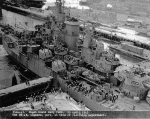 137k |
Tennessee (BB-43) at Puget Sound Navy Yard. 25 April, 1943, topside, port, at time of inclining experiment. | USN photo courtesy of Mike Green. |
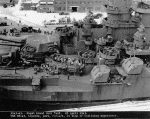 132k |
Tennessee (BB-43) at Puget Sound Navy Yard on 25 April, 1943, topside, port, forward, at time of inclining experiment.
| USN photo courtesy of Mike Green. |
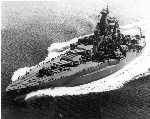 318k |
May 1943 photo. Radars either have not been equipped or have been erased by the censors. |
USN photo courtesy of Pieter Bakels. |
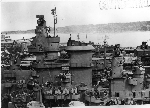 250k |
Tennessee (BB-43) Plan view, amidships of BK, BL-2,Mk.4,Mk.8,SC-2 and SG radar antennas. Note GFCS. Mk.49 just fwd.of her port Mk.37 Director. Puget Sound Navy Yard. 1 May, 1943. |
USN photo courtesy of Pieter Bakels. |
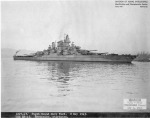 186k |
Tennessee (BB-43) at Puget Sound Navy Yard, 8 May 1943, one day after the completion of being completely rebuilt at Puget Sound Navy Yard. The ship was included in the refit program authorized for her salvaged sister, California (BB-44). The ship is wearing measure MS21 camouflage scheme.
| USN photo # 1227-43, courtesy of Mike Green. |
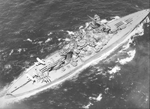 752k |
Tennessee (BB-43) not long after her post-Pearl Harbor repairs. Can you make out whether the OS2Us have red dots in the stars? I think they are there, but the photo is somewhat washed out. |
However, the other marking that went away from Navy aircraft in April/May 1942 (note that Lexington's (CVA-2) and Yorktown's (CVA-5) air groups still carried the red during Coral Sea) was the red and white stripes on the rudder. The fleet painted out these as well as the red centers in May, though the markings tended to bleed through the paint out after it bleached out in the sun. In the photo, the aircraft sitting on the main deck port side shows the rudder to be slighter lighter than the vertical stabilizer. This could be the over-exposed rudder markings or a slight difference in the angle of the rudder. Another hint is the size of the wing insignia, at some point these markings were enlarged to the full cord of the wing plus the four place location on the wings (rather than just one top and one bottom) I need to dig through resource I don't have here to check that data. My initial opinion is that there are no red markings on the aircraft but that this is still early probably April to August 1942. I'll revise that if I find something to change or confirm this opinion. The return of the national insignia on both upper & lower wing tips, as well as both sides of the fuselage, and the addition of red & white rudder stripes appears in a message from Commander-in-Chief, Pacific, 23 December 1941. (Elliott p62.) The directive for the large national insignia (full cord or maximum diameter possible without overflowing onto the aileron) was contained in a Bureau of Aeronautics letter of 5 January 1942. (Elliott p66-67, Doll p19). The red circle deleted from the national insignia and red & white stripes deleted from rudders appeared in May 1942 (6 May in Elliott p67, 15 May in Dole p19.) The wing insignia reverted to upper left and lower right positions in SR-2c Specification for Exterior Colors, Insignia and Marking of Naval Aircraft dated 5 January 1943, effective 1 February 1943. (Elliott p69, Doll p41.), so that would be your outside dates for these aircraft. USN photo courtesy of David Buell. |
Text i.d. courtesy of Chris Hoehn & Alan Moore.. Sources:Doll, Thomas E. US Navy Aircraft Camouflage and Markings 1940-1945. Carrollton, TX: Squadron/Signal Publications, 2003. Elliott, John M. The Official Monogram U.S. Navy and Marine Corps Aircraft Color Guide, Vol 2: 1940-1949, second edition. Sturbridge: Monogram Aviation Publications, 1998. Photo source courtesy of Alan Moore.. 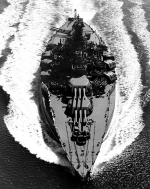 156k |
May 1943 photo of the Tennessee (BB-43) as rebuilt and on post refit trials. Not a flattering shot for a lady with a wide beam, but it readily shows the "new" hull design that was also applied to the California (BB-44) and West Virginia (BB-48). |
USN photo. |
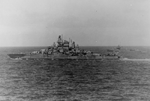 341k |
Tennessee (BB-43) early after her Bremerton rebuild. Sort of an ordinary photo of her, but at-sea photos in this period and in this rig of her are not so common.
|
USN photo courtesy of David Buell.
| 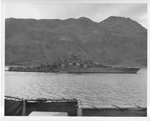 1.70k |
Tennessee meets Alaska on 20 July 1943. She appears here at anchor in Iliuliuk Bay. |
US National Archives photo # 19l-CM 200158 from NARA, College Park, Maryland, courtesy of Sean Hert.
|  64k |
Tennessee class (BB-43 /44) line drawing, 11/43. |
Courtesy of Joseph M. Radigan (of blessed memory). |
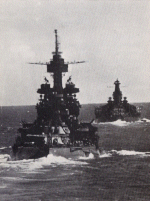 88k | Maryland (BB-46) follows Tennessee (BB-43), in mid-Pacific, November 1943. Originally near sisters,
note difference in beam and silhouette.
| Photo and text courtesy of U.S. Warships of W.W. II, by Paul H. Silverman, submitted by Robert Hurst. |
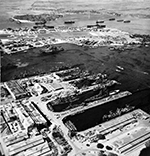 656k | Aerial of Pearl Harbor, Territory of Hawaii. Shown: Ship dispersal and docking areas. Photograph released 12 December 1943. | The BB at the navy yard pier is the New Mexico (BB-40) because of the mainmast configuration. Both of her sisters had their primary air search radar sets on the mainmast at the time. The three BB's nested by Ford Island are the Tennessee (BB-43) (outboard), Colorado (BB-45) in the middle, and Pennsylvania (BB-38) inboard on the Ford Island side. Note the 2 Essex class carriers off Ford Island, are probably Essex (CV-9) and Yorktown (CV-10), per "Location of U.S. Naval Aircraft," . In the insert photo (top left) note the Lexington (CV-16) in for drydock repairs suffered when attacked during a raid Kwajalein 4 December; she was hit by a torpedo to starboard, knocking out her steering gear. She was stateside on 26 December. Partial text courtesy of DANFS. | USN photo s # 80-G-221100 & 80-G-221098, now in the collections of the National Archives courtesy of the National Museum of the U.S. Navy, courtesy of flickr.com. Photo & text i.d. courtesy of Richard M. Jensen & Fabio Pena. 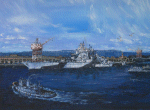 208k |
A painting by the artist Wayne Scarpaci entitled "Early evening." depicting the Tennessee (BB-43) arriving at NAS North Island, San Diego, CA. sometime in early 1944. | Painting courtesy of artbywayne.com. | 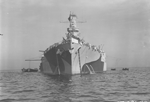 423k |
Bow view of Tennessee (BB-43) behind torpedo nets, taken off of San Francisco right after being painted up in camouflage measure 32, 11 January 1944.
|
BuShips photo # 57657 courtesy of David Buell. |  595k |
Interesting aerial shot of Tennessee (BB-43) at San Francisco wearing camouflage measure 32, 11 January 1944.
|
BuShips photo # 57660 courtesy of David Buell. | 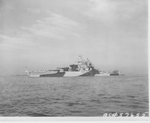 422k |
Broadside photo taken off of San Francisco in camouflage measure 32, 11 January 1944.
|
BuShips photo # 57655 courtesy of David Buell. |  1.19k |
The aerialphoto was taken by a Airship ZP-31 dated 13 January 1944 as Task Force 53 left San Pedro for Pearl Harbor and then on to the invasion of the Marshall Islands. Tennessee (BB-43) is seen with the amphibious attack group which includes a CVE, and LSD and various C2 and C3 amphibious ships. |
USN photo courtesy of David Buell. |
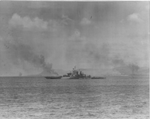 323k |
Tennessee (BB-43) shelling city of Garapan and Tanapag Harbor Saipan, in Marianas, 21 June 1944. |
USN photo # 80-G-238461 from National Archives and Records Administration (NARA), College Park, Maryland, courtesy of Sean Hert. |
 450k |
A camouflaged Tennessee (BB-43) and escorting destroyer are anchored offshore in 1944. |
USN photo courtesy of David Buell. |
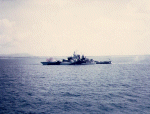 75k |
Bombarding Japanese positions on Guam, 19 July 1944. |
Official USN photo USNHC # 80-G-K-14224, now in the collections of the National Archives. |
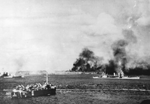 317k |
Bombardment of Angaur, circa 15 September 1944. Three U.S. Navy ships of Task Group 32.12 are visible (l-r): the battleship Tennessee (BB-43), wearing camouflage Measure 32 Design 1D; LST-689; and the heavy cruiser Minneapolis (CA-36), which wore a unique camouflage that should give her the silhouette of a destroyer. |
USN photo courtesy of Robert Hurst. |
 224k |
Tennessee (BB-43) during the shelling of Angaur, in the Palau Islands from 17 September—22 October 1944. |
USN photo # 80-G-284057 now in the collection of the US National Archives in College Park, Maryland, courtesy of Tracy White @ Researcher @ Large. /font>
| 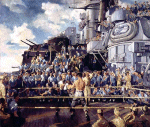 91k |
Oil on canvas by the artist William F. Draper entitled "Boxing Match". |
On the way to Saipan, the ship's company of the Tennessee (BB-43) gathers to watch a boxing match between two enlisted men. Courtesy of the Naval Historical Foundation. "Boxing Match"
William F. Draper #104
Oil on canvas, November 1944
40 1/4h" x 46w"
88-189-DS. |
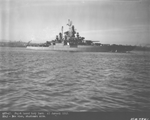 389k |
Bow view, starboard side of the Tennessee (BB-43) at Puget Sound Navy Yard, 25 January 1945. | Bureau of Ships photos # 78466 courtesy of David Buell.
|  270k |
The Tennessee's (BB-43) 5"/38' reach for the sky in this photo taken some time after her last refit at Puget Sound Navy Yard, 25 January 1945. | National Archives, # N-3136 courtesy of David Buell. |
Photo i.d. courtesy of David C. Nilsen, CTR USA, TRADOC.  1.19k | A class act: Tennessee (BB-43) & California (BB-44). | Official USN photo courtesy The Ships and Aircraft of the United States Fleet by Admiral James C. Fahey, courtesy of Tommy Trampp.
| 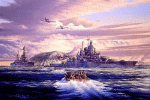 76k |
Oil on canvas painting by the artist Anthony Saunders entitled "Tennessee (BB-43) During the Landings at Iwo Jima." | In February 1945, 850 square miles of volcanic rock became the most strategically important island in the South Pacific. From Iwo Jima heavy bombers would be able to raid Japanese cities almost at will. Even with its overwhelming military might, the Americans would have to pay a heavy price for such a seemingly small island. The battleship New York (BB-34) is behind the Tennessee Text and drawing courtesy of naval-art.com | 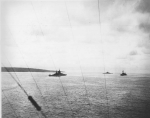 76k | Photo taken from Vicksburg (CL-86) of the battleships Idaho (BB-42), Tennessee (BB-43), and New York (BB-34) (on right), during the bombardment of Iwo Jima, February 1945.
| Courtesy of modelwarships.com & submitted by Joesph Macdonald. | 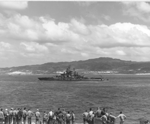 410k |
Tennessee (BB-43) anchored at Saipan. Flight deck crew of Sargent Bay (CVE-83) in foreground, 13 February 1945. |
USN photo # 80-G-321504 from National Archives and Records Administration (NARA), College Park, Maryland, courtesy of Sean Hert. |
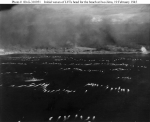 65k |
Initial waves of amphibious tractors (LVT) head for the landing beaches on Iwo Jima's southeastern coast, at about 0900 Hrs. on 19 February 1945.
Tennessee (BB-43) is at left.
Photographed from an airplane based on Makin Island (CVE-93).
|
Official USN photo # 80-G-310951, now in the collections of the National Archives. |
 717k |
Tennessee (BB-43) and the Invasion Fleet off Iwo Jima. Note LVTs and LCIs maneouvering near to Tennessee.
|
USN photo from the North Carolina (BB-55) World War II cruise book courtesy of Robert Hurst. |
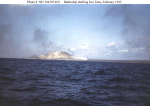 48k |
A battleship, probably Tennessee (BB-43) bombarding Iwo Jima prior to the initial landings, circa 19 February 1945. Mount Suribachi is in the left center, beyond the battleship, with a huge explosion at its base. | Original 35mm Kodachrome transparency, photographed by Lieutenant Howard W. Whalen, USNR, Boat Group Commander, Sanborn (APA-193). U.S. Naval Historical Center Photograph # NH 104355-KN. Collection of Lieutenant Commander Howard W. Whalen, USNR. Donated by Mrs. Nadine Whalen, 1997. | 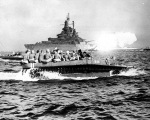 128k |
Bombarding Okinawa with her 14"/50 main battery guns, as LVTs in the foreground carry troops to the invasion beaches, 1 April 1945. |
USNHC # NH 42390, now in the collections of the National Archives. |
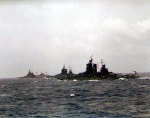 70k |
At sea with two other battleships and an amphibious force command ship (AGC), probably at the time of the Iwo Jima or Okinawa operations, circa February-April 1945. Battleship in the center background is Idaho (BB-42). The one further to the left is Tennessee (BB-43). |
Official USN photo USNHC # 80-G-K-3706, now in the collections of the National Archives. |
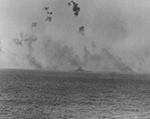 221k | During suicide attack by five Japanese planes on US fleet off Okinawa, the Tennessee (BB-43) is hit on port side, 12 April 1945. As seen from the Nevada (BB-36). | The Idaho (BB-42) is at right, in the distance a destroyer is burning. USN photo # 80-G-323590 & 80-G-323591 (insert) from National Archives and Records Administration (NARA), College Park, Maryland, courtesy of Sean Hert. |  1.41k | Kamikaze attacks on Tennessee (BB-43), 12 April 1945. Possibly, to the left, Zellars (DD-777), also attacked that day. | USN photo # 89-20-M, artwork by John Hamilton from his publication, War at Sea. Courtesy of the U.S. Navy Art Gallery from the National Museum of the U.S. Navy via flickr.com. |  23k |
Damage from a kamikaze attack on the Tennessee (BB-43), 12 April 1945 off the coast of Okinawa. | Photo from WW II Damage Reports, courtesy of NavSea / dcfp.navy.mil. |
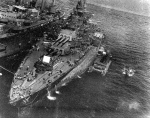 174k |
Tennessee (BB-43) beside the repair ship Ajax (AR-6) on 8 May 1945, undergoing repairs to her starboard side gun mounts after a kamikaze struck the ship on 12 April 1945. |
Photo taken by Hamp Law from the backseat of OS2U Kingfisher number 22 as they were doing a fly-by of the ship. Photo & text courtesy of Model Warships submitted by Mike Green. |
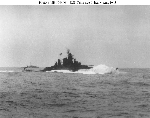 51k |
Tennessee (BB-43) pitching in heavy seas, while operating in the Pacific Ocean, 1945.
|
Official USN photo # NH 104440, now in the collections of the National Archives. Collection of Rear Admiral Calvin T. Durgin, USN, donated by his Daughter, Mrs. Phyllis Sherrill, 1972. |
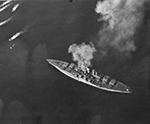 190k | Tennessee (BB-43) training her guns on Okinawa, Ryukyu Island, defenses during invasion, as landing craft scurry to shore. | USN photo # 80-G-314670 from National Archives and Records Administration (NARA), College Park, Maryland, courtesy of Sean Hert. |  82k | Pearl Harbor Veterans, the Tennessee (BB-43), California (BB-44) and Nevada (BB-36) steam out of Buckner Bay, Okinawa on 17 July 1945. All had been sunk or damaged during the attack on Pearl Harbor. | USN photo. | 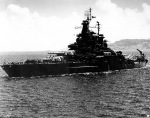 124k |
In Buckner Bay, Okinawa, 17 July 1945. Taken by a Makin Island (CVE-93) photographer. |
Official USN photo USNHC # 80-G-326899, now in the collections of the National Archives. |
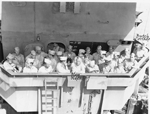 584k |
Vice Admiral Jesse B. Oldendorf (center) with his Flag Personnel on the Flag Bridge of Tennessee (BB-43) in August 1945 at Okinawa. |
USN photo courtesy of Yu Chu.
| Post War / Scrapping |
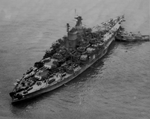 1.30k | PHILADELPHIA, December 7. BATTLESHIP TENNESSEE (BB-43) COMES HOME - Four years after Pearl Harbor, the battleship Tennessee which survived two bomb hits in the sneak attack arrived home today after a 15,000 mile journey from Tokyo Bay. A tug pushes the ship up the Delaware to the Philadelphia Navy yard. | A.P. Wire photo courtesy of David Buell.
| 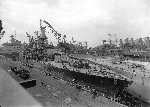 667k | Photo taken from Bldg. 620 of Drydock # 5 at Philadelphia Naval Shipyard. | The Tennessee (BB-43) in the foreground and the fore section of the California (BB-44) outboard at the Philadelphia Naval Shipyard sometime after 8 May 1946. Note that they are both still flying their ensigns and jacks, so both are still in commission. The South Dakota (BB-57) is in the left background. Across the pier past the California are two 4-stack cruisers of the Omaha class. Stripping is apparently underway on the CLs, with at least one smokestack (on the nearest -- inboard -- ship) removed. Some of the stacks on the outboard ship are hidden behind those of the inboard ship. It appears that the cruisers might be painted in measure MS-21 camouflage, but only two appear to have ended the war in this pattern: Detroit (CL-8) and Trenton (CL-11). Seven of these cruisers were decommissioned and sold for scrap at the Phila. Navy Yard: (1) Omaha (CL-4) scrapped beginning 2/46. (MS-22) dated 1945. (2) Cincinnati (CL-6) scrapping beginning 2/27/46. (MS-22) dated 1945. (3) Raleigh (CL-7) scrapping beginning 2/27/46. (MS32/1D) dated 1944. (4) Detroit scrapping beginning 2/27/46. (MS22 & MS21) dated 1945. (5) Concord (CL-10) scrapping beginning 2/27/47. (MS33/2F) dated 1944. (6) Trenton (CL-11) scrapping beginning 12/29/46. (MS21) dated 1945. (7) Marblehead (CL-12) scrapping beginning 2/27/46.(MS22) dated 1945. It is possible that the outboard cruiser (further from the camera) may not be in measure 21. The stack appears a bit lighter and that would mean cruisers in measure 22 would also have to be included. Note that #4 stack of the outboard cruiser is obscured by #3 of the inboard ship (which also looks a little bit lighter?). In any case both Richmond (CL-9) and Memphis (CL-13) would also have to be considered. This is especially true since Richmond was in MS 21 in late 1945. Also in the background is the former Olympia (ex-C-6) (IX-40). Notice the flatcar going to the storage yards on other side of the lift bridge to Bldg. 750. It is full of single barrel 20mm A.A. mounts is in the foreground on the train/trolley tracks. USN photo courtesy of Pieter Bakels. Partial text and photo i.d. and a lot of homework courtesy of Mike Green, Aryeh Wetterhorn, Chuck Haberlein, Tracy White @ Researcher @ Large. & Joe Lewis & Ron Reeves (of blessed memory) (HTC) USNR (ret.) |
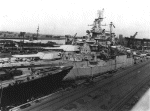 330k | California (BB-44) in the foreground and the fore section of the Tennessee (BB-43) outboard at the Philadelphia Naval Shipyard sometime after 8 May 1946. | USN photo courtesy of floatingdrydock.com. & submitted by David Buell. Photo i.d. courtesy of Joe Lewis. |
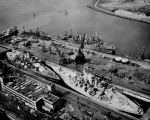 102k | Battleships in dry-dock; Tennessee (BB-43) & California (BB-44) taken between 8 May and 27 October 1946. | This photo comes from the U.S.Naval Institute and has an accompanying photocopy identifying all of the surrounding ships. It does identify the two cruisers as Detroit (CL-8) (inboard) and Trenton (CL-11)(outboard). It also identifies two returned U.K. DEs: HMS Rupert (DE-96) outboard of Olympia (ex-C-6) (IX-40), and HMS Berry (DE-3) ahead of the cruisers, and visible in the California's photo (it's still wearing its British hull #--K312). The Naval Institute photo was taken at a later date, as more of the "packaging" on the two battleships had been completed. According to Tennessee's deck logs, she entered Drydock #5 with California on 8 May 1946. South Dakota (BB-57) (mid-stern section visible at upper left of photo) subsequently entered Drydock #4--the 1946 "Navy Day" program from the shipyard indicates that this had taken place by 27th October of that year. The four CLs that were scrapped in Drydock #4 at the Philadelphia NSY were: Omaha (CL-4), Cincinnati (CL-6), Raleigh (CL-7) and Marblehead (CL-12). I have two documents from the 4th Naval District, and of course they give different completion dates for the scrapping of these ships. The first document (dated 1 Apr 46) indicates that scrapping was completed on 27 February of that year; the second document (also dated 1 April 46) gives the completion date as 10 March 1946. (My notes also indicate that scrapping was completed at the yard on nine ex-destroyer types as of 29 March 46: Litchfield (DD-336), Pruitt (DD-347), Jouett (DD-396), Clark (DD-361), Balch (DD-363), Sampson(DD-394), Schley (DD-103), Stringham (DD-83) and Whipple (DD-217). The remaining CLs; Detroit (CL-8), Trenton (CL-11), Richmond (CL-9), Concord (CL-10) and Memphis (CL-13) were all sold to the Patapsco Scrap Co. of Baltimore. The sales bid (B-76-47AV T) was opened on 6 December 46; the five ships were sold for $336,140 (or $67,228 each), and custody of the ships was transferred to Patapsco between 27 December 46 and 21 January 47. Note also that the attached photo distinctly shows that both cruisers have all four funnels--I think it's an optical illusion that either of these had had any of them removed. The "light colored objects" in front of the two cruisers might "possibly" be barbettes from the Illinois (BB-65). According to drawings in the 1945 "Gun Mount and Turret Catalog", these two items appear to be about the same diameter as the barbettes for the two BBs' Tennessee & California; 14"/50 triple gun turrets; inside diameter 31 feet, from the same source -- outside diameter would have been about 33 feet. The Illinois barbettes would have an inside diameter about 37 1/4 feet, outside diameter rather over 39 feet. USN photo submitted by Joe Lewis, courtesy of U.S.Naval Institute. Majority text by Joe Lewis. |
Chuck Haberlein contributed to the (BB-65) i.d. with text. 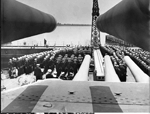 286k | Looking down the after guns on the quarterdeck of the Tennessee (BB-43), as ship's company lines up for the Navy Unit Commendation for the ship's 13 major engagements from Guadalcanal to Okinawa, 13 May 1946.
| Photo courtesy of the George D. McDowell Philadelphia Evening Bulletin Photographs @ digital.library.temple.edu.
| 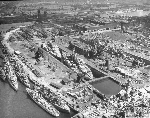 216k |
The US armed forces ship storage yard at Philadelphia, PA, 29 August 1946. |
The battleship South Dakota (BB-57) is in the foreground. The Tennessee (BB-43) is to the upper left and the California (BB-44) is to the lower right. Note also the Light Cruisers of the Cleveland Class (CL-55 / 106); possibly Columbia (CL-56), Montpelier(CL-57) or Denver(CL-58) in Drydock # 4. Photographer: Sam Shere, courtesy of time.com. via / images.google.com & Life. | Photo i.d. courtesy of Ron Reeves (of blessed memory), (HTC) USNR (ret.) 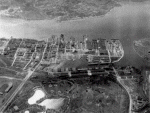 105k |
The Philadelphia Naval Shipyard in 1947. On the upper right side near the channel entrance, the mothballed battleships Tennessee (BB-43) and California (BB-44) are in a drydock.
|
USN photo courtesy of Joe MacDonald. |
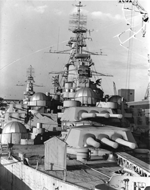 247k | The Tennessee (BB-43) & California (BB-44) at the Philadelphia Navy Base Shipyard, 1949. | USN photo courtesy of Scott Koen & ussnewyork.com. |
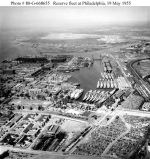 138k | Reserve Fleet Basin, Philadelphia Naval Shipyard, Pennsylvania. Photographed on 19 May 1955 with numerous cruisers, escort carriers, and auxiliaries in reserve. The nearest ship is the never-completed Hawaii (CB-3), which lacks its previously-installed three 12" gun turrets. | The cruisers outboard of Hawaii are (in unknown order) Honolulu (CL-48), Columbia (CL-56), Denver (CL-58), Galveston (CL-93), and Portsmouth (CL-102). To their left are Tranquility (AH-14), Sanctuary (AH-17), and Pocono (AGC-16). Behind Hawaii (from left to right) are Montpelier (CL-57), Houston (CL-81), Huntington (CL-107), Savannah (CL-42), Cleveland (CL-55), and Wilkes-Barre (CL-103). Beyond them (from left to right) are Wichita (CA-45), Oregon City (CA-122), Chester (CA-27), and New Orleans (CA-32). The cruisers on the left side of the basin (from front to rear) are Minneapolis (CA-36), Tuscaloosa (CA-37), San Francisco (CA-38), Augusta (CA-31), Louisville (CA-28), and Portland (CA-33). Among the other ships in reserve in the basin are Fomalhaut (AE-20), Webster (ARV-2), Albemarle (AV-5), Tangier (AV-8), Pocomoke (AV-9), Chandeleur (AV-10), Abatan (AW-4), Mission, San Carlos (AO-120), Prince William (CVE-31), Anzio (CVE-57), Block Island (CVE-106), Palau (CVE-122), and San Carlos (AVP-51). Moored in the shipyard at the extreme left are Tennessee (BB-43), California (BB-44), and Cabot (CVL-28). Official USN photo USNHC # 80-G-668655, now in the collections of the National Archives. |
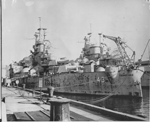 611k | On Inactive Duty: The Tennessee (BB-43) & California (BB-44), right background, two of the eight U.S. battleships bombed by the Japanese in their surprise attack on Pearl Harbor 15 years ago, ride quietly at anchor in the "mothball fleet" at the Philadelphia Navy Base Shipyard, 6 December 1956. | A .P. Wirephoto courtesy of David Buell. |  43k |
Tennessee (BB-43) awaiting scrapping at Baltimore, Maryland in 1959. |
USN photo , courtesy of Robert Sumrall, via Myron J. Smith Jr, from his book "Volunteer State Battlewagon", from Pictorial Histories Publishing, Missoula, Montana. |
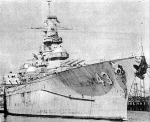 140k |
Photo from an 11 June 1959 sales brochure announcing the sale of the "Big Five" battleships, the Tennessee (BB-43) among them. Here she sits at the Philadelphia Naval Shipyard.
|
USN photo by Mike Green and text courtesy of Model Warships. |
 76k |
Tennessee (BB-43) awaiting scrappingat Baltimore, Maryland in 1959. |
USN photo , courtesy of Robert Sumrall, via Myron J. Smith Jr, from his book "Volunteer State Battlewagon", from Pictorial Histories Publishing, Missoula, Montana. |
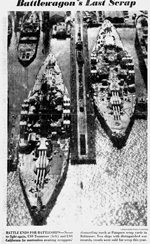 2.34k |
The Tennessee (BB-43)& California (BB-44) awaiting scrapping by Bethlehem Steel Co. 1959. |
Photo courtesy of The San Francisco Examiner 22 October 1959, via Joe MacDonald. |
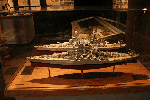 130k |
Models of the Tennessee (BB-43) at the Military Museum in Nashville - which is apart of the University of Tennessee. The models shows the Tennessee in both pre-war and post reconstruction modes. There are a couple of close ups showing details of the bridge area of the superstructure. |
Photo courtesy of Larry lee via Gary Priolo. |
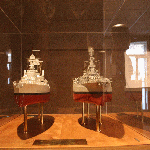 199k |
Bow on view of the Tennessee (BB-43) in both pre-war and post reconstruction modes. |
Photo courtesy of Larry lee via Gary Priolo. |
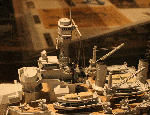 159k |
Superstructure close up of the Tennessee (BB-43) in pre-war mode. |
Photo courtesy of Larry lee via Gary Priolo. |
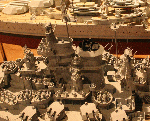 175k |
Superstructure close up of the Tennessee (BB-43) in post reconstruction mode. |
Photo courtesy of Larry lee via Gary Priolo. |
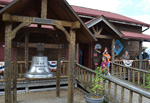 014300e 929k | Tennessee's (BB-43) bell on display at Museum of Scott County. | Photo courtesy of Yu Chu.
|
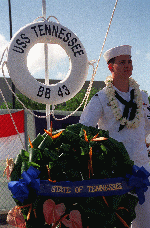 575k |
PO2 Ric Walker stands by the memorial wreath for the Tennessee (BB-43) during Survivor's Day ceremonies at the Arizona Memorial Visitors Center, 5 December 1991. The event honors the sailors and Marines of the battleships that were sunk or damaged in the 7 December 1941 attack on Pearl Harbor.
|
USN photo # DN-SC-92-05801, by PHC Chet King, courtesy of dodmedia.osd.mil, Defense Visual Information Center. |
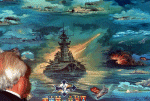 371k | A guest studies a painting depicting the history of battleships. The artwork was painted by George Skybeck and presented to the Pearl Harbor Survivors Association during their annual banquet at Honolulu, Hawaii, on 8 December 1991.
| USN photo # DN-SC-92-05391, by PHC Carolyn Harris, courtesy of dodmedia.osd.mil, Defense Visual Information Center. |
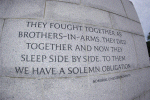 371k | A quote made by Fleet Adm. Chester W. Nimitz is inscribed on a granite wall at the National World War II Memorial located on the National Mall in Washington, D.C. Fleet Adm. Nimitz was the United States signatory to the surrender terms aboard the battleship Missouri (BB-63) in Tokyo Bay, Japan on 2 September 1945, thus ending World War II. Established by the American Battle Monuments Commission, the memorial honors all military veterans of World War II, the citizens on the home front, the nation at large, and the high moral purpose and idealism that motivated the nation's call to arms. On 29 May 2004, the memorial was formally dedicated with an estimated 200,000 people expected to attend, and includes 100,000 visiting veterans of all wars. | USN photo # N-0295M-011 by Photographer's Mate 2nd Class Daniel J. McLain, courtesy of news.navy.mil. | | |||||||||||||||||||||||||||||||||||||||||||||||||||||||||||||||||||||||||||||||||||||||||||||||||||||||||||||||||||||||||||||||||||||||||||||||||||||||||||||||||||||||||||||||||||||||||||||||||||||||||||||||||||||||||||||||||||||||||||||||||||||||||||||||||||||||||||||||||||||||||||||||||||||||||||||||||||||||
| Commanding Officers | ||
| 01 | CAPT. Leigh, Richard Henry, USN (USNA 1891) :ADM | 03.06.20 - 1921 |
| 02 | CAPT. Williams, Philip, USN (USNA 1889) | 1922 - 09.11.1923 |
| 03 | CAPT. McNamee Jr., Luke R., USN (USNA 1892) :ADM | 09.11.1923 - 05.09.1924 |
| 04 | CAPT. Upham, Frank Brooks, USN (USNA 1893) :RADM | 05.09.1924 - 29.03.1926 |
| 05 | CAPT. Stone, George Loring Porter, USN (USNA 1894) :VADM | 29.03.1926 - 00.12.1927 |
| 06 | CAPT. Pettengill, George Tilford, USN :RADM) | 00.12.1927 - 08.06.1929 |
| 07 | CAPT. Courtney, Charles Edward, USN (USNA 1899) :RADM | 08.06.1929 - 15.06.1931 |
| 08 | CAPT. Snyder, Charles Philip, USN (USNA 1896) :ADM | 15.06.1931 - 09.08.1932 |
| 09 | CAPT. Smyth, William Woods, USN (USNA 1903) | 09.08.1932 - 04.05.1934 |
| 10 | CAPT. Benson, Howard Hartwell James, USN (USNA 1909) :COMO | 04.05.1934 - 01.06.1934 |
| 11 | CAPT. Davis, Milton Smith, USN (USNA 1903) | 01.06.1934 - 01.07.1936 |
| 12 | CAPT. McNair, Laurance North, USN (USNA 1905) | 01.07.1936 - 08.05.1937 |
| 13 | CAPT. Stapler, John Taylor Gause, USN (USNA 1906) | 08.05.1937 - 24.07.1937 |
| 14 | CAPT. Wolleson, Edwin Armin, USN (USNA 1906) | 24.07.1937 - 15.12.1938 |
| 15 | CAPT. Cummings, Damon Earhart, USN (USNA 1907) | 15.12.1938 - 01.07.1940 |
| 16 | CAPT. Ingram, Jonas Howard, USN (USNA 1907) :ADM | 01.07.1940 - 31.12.1940 |
| 17 | CAPT. Reordan, Charles Edwin, USN (USNA 1909) | 31.12.1940 - 20.06.1942 |
| 18 | CAPT. Haggart, Robert Stevenson, USN (USNA 1912) :COMO | 20.06.1942 - 25.03.1944 |
| 19 | CAPT. Mayer, Andrew DeGraff, USN (USNA 1916) | 25.03.1944 - 10.10.1944 |
| 20 | CAPT. Heffernan, John Baptist, USN (USNA 1917) :RADM | 10.10.1944 - 07.09.1945 |
| 21 | CAPT. Cope, Harley Francis, USN (USNA 1920) | 07.09.1945 - 11.02.1946 |
| 22 | CDR. Abbot, Edward William, USN (USNA 1938) | 11.02.1946 - 10,10.1946 |
| 23 | CDR. Wadsworth, Victor Flemming, USN | 10.10.1946 - 17.02.1947 |
The contact listed, Was the contact at the time for this ship when located. If another person now is the contact, E-mail me and I will update this entry. These contacts are compiled from various sources over a long period of time and may or may not be correct. Every effort has been made to list the newest contact if more than one contact was found.
| Back To The Main Photo Index | Back To The Battleship Photo Index Page |